JBoss ESB 4.6
Services Guide
JBESB-SG-7/17/09
Legal
Notices
The
information contained in this documentation is subject to change
without notice.
JBoss Inc.
makes no warranty of any kind with regard to this material,
including, but not limited to, the implied warranties of
merchantability and fitness for a particular purpose. JBoss Inc.
shall not be liable for errors contained herein or for incidental or
consequential damages in connection with the furnishing, performance,
or use of this material.
Java™ and
J2EE is a U.S. trademark of Sun Microsystems, Inc. Microsoft® and
Windows NT® are registered trademarks of Microsoft Corporation.
Oracle® is a registered U.S. trademark and Oracle9™, Oracle9
Server™ Oracle9 Enterprise Edition™ are trademarks of Oracle
Corporation. Unix is used here as a generic term covering all
versions of the UNIX® operating system. UNIX is a registered
trademark in the United States and other countries, licensed
exclusively through X/Open Company Limited.
Copyright
JBoss, Home
of Professional Open Source Copyright 2006, JBoss Inc., and
individual contributors as indicated by the @authors tag. All rights
reserved.
See the
copyright.txt in the distribution for a full listing of individual
contributors. This copyrighted material is made available to anyone
wishing to use, modify, copy, or redistribute it subject to the terms
and conditions of the GNU General Public License, v. 2.0. This
program is distributed in the hope that it will be useful, but
WITHOUT A WARRANTY; without even the implied warranty of
MERCHANTABILITY or FITNESS FOR A PARTICULAR PURPOSE.
See the GNU
General Public License for more details. You should have received a
copy of the GNU General Public License, v. 2.0 along with this
distribution; if not, write to the Free Software Foundation, Inc., 51
Franklin Street, Fifth Floor, Boston, MA 02110-1301, USA.
Software
Version
JBoss ESB 4.6
Restricted
Rights Legend
Use,
duplication, or disclosure is subject to restrictions as set forth in
contract subdivision (c)(1)(ii) of the Rights in Technical Data and
Computer Software clause 52.227-FAR14.
© Copyright
2009 JBoss
Inc.
�
Contents
Contents iii
About
This Guide 5
What
This Guide Contains 5
Audience 5
Prerequisites 5
Documentation
Conventions 5
Additional
Documentation 6
Contacting Us 6
What is the
Registry? 8
Introduction 8
Why do I need it
? 8
How do I use it
? 8
Registry Vs
Repository 8
SOA components 9
UDDI 9
The Registry and
JBossESB 10
Configuring the
Registry 11
Introduction 11
The components
involved 12
The Registry
Implementation Class 12
Using JAXR 13
Using Scout and
jUDDI 13
Chapter 3 15
Registry
Configuration Examples 15
Introduction 15
Embedded 15
RMI using the
juddi.war or jbossesb.sar 16
RMI using your
own JNDI Registration of the RMI Service 17
2.4 SOAP 19
UDDI Browser 22
Introduction 22
UB setup 22
Chapter 4 25
Registry
Troubleshooting 25
Scout
and jUDDI pitfalls 25
More
Information 25
What is a Rule
Service? 26
Introduction 26
Rule Services
using Drools 28
Introduction 28
Rule Set
Creation 28
Rule Service
Consumers 29
Configuration 30
Object Paths 34
Deployment and
Packaging 34
What is
Content-Based
Routing? 36
Introduction 36
Simple example 36
Content Based
Routing using Drools 38
Introduction 38
Three different
routing action classes 38
org.jboss.soa.esb.actions.ContentBasedRouter
38
org.jboss.soa.esb.actions.ContentBasedWireTap 38
org.jboss.soa.esb.actions.MessageFilter.
38
Rule Set
Creation 39
XPath Domain
Specific Language 39
XPath and
namespaces 40
Configuration 40
Object Paths 42
Stateful Rules 43
RuleAgent 43
RuleAgent and
Business Rule Management System 44
Executing
Business Rules 44
Changing
RuleService implementations 44
Deployment and
Packaging 44
Content Based
Routing using Smooks 46
Introduction 46
Message
Transformation 48
Overview 48
Smooks 48
Samples &
Tutorials 48
XSL
Transformations 49
jBPM
Integration 50
Introduction 50
Integration
Configuration 50
jBPM
configuration 52
Creation and
Deployment of a Process Definition 53
JBossESB to
jBPM 56
Exception
Handling JBossESB to jBPM 58
jBPM to
JBossESB 58
EsbNotifier 58
EsbActionHandler 60
Exception
Handling jBPM -> JBossESB 61
Scenario 1.
Time-out 61
Scenario 2.
Exception Transition 63
Scenario 3.
Exception Decision 63
Service
Orchestration 65
Introduction 65
Orchestrating Web
Services 65
Orchestration
Diagram 65
Process
Deployment and Instantiation 73
Conclusion 75
The Message
Store 76
Introduction 76
Message Store
interface 76
Transactions 77
Configuring the
Message Store 77
Security 80
Introduction 80
Security Service
Configuration 80
Configuring
Security on Services 82
Authentication
83
JBossESB
SecurityContext 84
Security Context
Propagation 84
Implementations
of SecurityContextPropagator 85
Customizing
security 85
Provided Login
Modules 86
CertificateLoginModule 86
Role Mapping 87
SecurityService 87
References 89
Index 90
�
About
This Guide
What This Guide
Contains
The
Services Guide contains important
information on changes to JBoss ESB 4.6 since
the last release and information on any outstanding issues.
Audience
This
guide is most relevant to engineers who are responsible for
administering JBoss ESB 4.6 installations.
Prerequisites
None.
Documentation
Conventions
The
following conventions are used in this guide:
|
Convention |
Description |
|
Italic |
In paragraph text,
italic identifies the titles of documents that are being
referenced. When used in conjunction with the Code text
described below, italics identify a variable that should be
replaced by the user with an actual value. |
|
Bold |
Emphasizes items
of particular importance. |
|
Code |
Text that
represents programming code. |
|
Function
| Function |
A path to a
function or dialog box within an interface. For example,
“Select File | Open.” indicates that you should select the
Open function from the File menu. |
|
( ) and | |
Parentheses
enclose optional items in command syntax. The vertical bar
separates syntax items in a list of choices. For example, any of
the following three items can be entered in this syntax:
persistPolicy
(Never | OnTimer | OnUpdate | NoMoreOftenThan) |
Note:
Caution:
|
A note highlights
important supplemental information.
A caution
highlights procedures or information that is necessary to avoid
damage to equipment, damage to software, loss of data, or
invalid test results. |
Table 1
Formatting Conventions
Additional
Documentation
In
addition to this guide, the following guides are available in the JBoss ESB 4.6
documentation set:
JBoss ESB 4.6
Getting
Started Guide:
Provides a quick start reference to configuring and using the ESB.
JBoss ESB 4.6
Programmers
Guide:
How to use JBossESB.
JBoss ESB 4.6 Release
Notes: Information on the differences between this release and
previous releases.
JBoss ESB 4.6 Administration
Guide: How to manage the ESB.
Contacting Us
Questions
or comments about JBoss ESB 4.6
should be directed to our support team.
�
�
Chapter 1
What is the Registry?
Introduction
In
the context of SOA, a registry provides applications and businesses
a central point to store information about their services. It is
expected to provide the same level of information and the same
breadth of services to its clients as that of a conventional market
place. Ideally a registry should also facilitate the automated
discovery and execution of e-commerce transactions and enabling a
dynamic environment for business transactions. Therefore, a
registry is more than an “e-business directory”. It is an
inherent component of the SOA infrastructure.
Why do I need it ?
It
is not difficult to discover, manage and interface with business
partners on a small scale, using manual or ad hoc techniques.
However, this approach does not scale as the number of services,
the frequency of interactions, the physical distributed nature of
the environment, increases. A registry solution based on agreed
upon standards provides a common way to publish and discover
services. It offers a central place where you query whether a
partner has a service that is compatible with in-house technologies
or to find a list of companies that support shipping services on
the other side of the globe.
Service
registries are central to most service oriented architectures and
at runtime act as a contact point to correlate service requests to
concrete behaviors. A service registry has meta-data entries for
all artifacts within the SOA that are used at both runtime and
design time. Items inside a service registry may include service
description artifacts (e.g., WSDL), Service Policy descriptions,
various XML schema used by services, artifacts representing
different versions of services, governance and security artifacts
(e.g., certificates, audit trails), etc. During the design phase,
business process designers may use the registry to link together
calls to several services to create a workflow or business process.
The
registry may be replicated or federated to improve performance and
reliability. It need not be a single point of failure.
How do I use it ?
From
a business analyst’s perspective, it is similar to an Internet
search engine for business processes. From a developers
perspective, they use the registry to publish services and query
the registry to discover services matching various criteria.
Registry Vs
Repository
A
registry allows for the registration of services, discovery of
metadata and classification of entities into predefined categories.
Unlike a respository, it does not have the ability to store
business process definitions or WSDL or any other documents that
are required for trading agreements. A registry is essentially a
catalogue of items, whereas a repository maintaines those items.
SOA
components
As the
W3C puts it: An SOA is a
specific type of distributed system in which the agents are
"services"
(http://www.w3.org/TR/2003/WD-ws-arch-20030808/#id2617708).
The
key components of a Service Oriented Architecture are the messages
that are exchanged, agents that act as service requesters and
service providers, and shared transport mechanisms that allow the
flow of messages. A description of a service that
exists within an SOA is essentially just a description of the
message exchange patter between itself and its users. Within
an SOA there are thus three critical roles: requester,
provider, and broker.
Service
provider: allows access to services, creates a description of a
service and publishes it to the service broker.
Service
broker: hosts a registry of service descriptions. It is
responsible for linking a requestor to a service provider.
Service
requester: is responsible for discovering a service by searching
through the service descriptions given by the service broker. A
requestor is also responsible for binding to services provided by
the service provider.
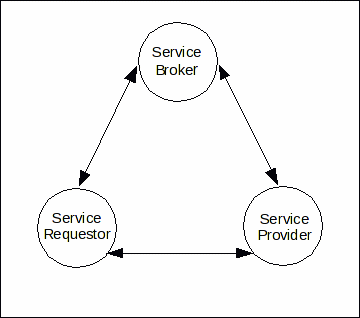
UDDI
The
Universal Description, Discovery and Integration registry is a
directory service for Web Services. It enables service discovery
through queries to the UDDI registry at design time or at run time.
It also allows providers to publish descriptions of their services
to the registry. The registry typically contains a URL that locates
the WSDL document for the web services and contact information for
the service provider. Within UDDI information is classified into
the following categories.
White
pages: contain general information such as the name, address and
other contact information about the company providing the service.
Yellow
pages: categorize businesses based on the industry their services
cater to.
Green
pages: provide information that will enable a client to bind to the
service that is being provided.
The Registry and
JBossESB
The
registry plays a central role within JBossESB. It is used to store
endpoint references (EPRs) for the services deployed within the
ESB. It may be updated dynamically when services first start-up, or
statically by an external administrator.
As
with all environments within which registries reside, it is not
possible for the registry to determine the liveness of the entities
its data represents, e.g., if an EPR is registered with the
registry then there can be no guarantee that the EPR is valid (it
may be malformed) or it may represent a services that is no longer
active. At present JBossESB does not perform life-cycle monitoring
of the services that are deployed within it. As such, if services
fail or move elsewhere, their EPRs that may reside within the
registry will remain until they are explicitly updated or removed
by an administrator. Therefore, if you get warnings or errors
related to EPRs obtained from the registry, you should consider
removing any out-of-date items.
�
Chapter 2
Configuring the Registry
Introduction
The
JBossESB Registry architecture allows for many ways to configure
the ESB to use either a Registry or Repository. By default we use a
JAXR implementation (Scout) and a UDDI (jUDDI), in an embedded way.
The
following properties can be used to configure the JBossESB
Registry. In the
jbossesb-properties.xml there is section called 'registry':
<properties name="registry">
<property name="org.jboss.soa.esb.registry.implementationClass" value="org.jboss.internal.soa.esb.services.registry.JAXRRegistryImpl"/>
<property name="org.jboss.soa.esb.registry.factoryClass" value="org.apache.ws.scout.registry.ConnectionFactoryImpl"/>
<property name="org.jboss.soa.esb.registry.queryManagerURI" value="org.apache.juddi.registry.local.InquiryService#inquire"/>
<property name="org.jboss.soa.esb.registry.lifeCycleManagerURI" value="org.apache.juddi.registry.local.PublishService#publish"/>
<property name="org.jboss.soa.esb.registry.user" value="jbossesb"/>
<property name="org.jboss.soa.esb.registry.password" value="password"/>
<property name="org.jboss.soa.esb.scout.proxy.transportClass" value="org.apache.ws.scout.transport.LocalTransport"/>
<!-- specify the interceptors, in order -->
<property name="org.jboss.soa.esb.registry.interceptors"
value="org.jboss.internal.soa.esb.services.registry.InVMRegistryInterceptor, org.jboss.internal.soa.esb.services.registry.CachingRegistryInterceptor"/>
<!-- The following properties modify the cache interceptor behaviour -->
<property name="org.jboss.soa.esb.registry.cache.maxSize" value="100"/>
<property name="org.jboss.soa.esb.registry.cache.validityPeriod" value="600000"/>
<!-- Organization Category to be used by this deployment. -->
<property name="org.jboss.soa.esb.registry.orgCategory"
value="org.jboss.soa.esb.:category"/>
</properties>
|
Property |
Description |
|
org.jboss.soa.esb.registry.implementationClass |
A class
that implements the jbossesb Registry interface. We have provided
one implementation (JAXRRegistry interface). |
|
org.jboss.soa.esb.registry.factoryClass |
The class
name of the JAXR ConnectionFactory implementation. |
|
org.jboss.soa.esb.registry.queryManagerURI |
The URI
used by JAXR to query. |
|
org.jboss.soa.esb.registry.lifeCycleManagerURI |
The URI used by JAXR to edit.
|
|
org.jboss.soa.esb.registry.user |
The user used for edits.
|
|
org.jboss.soa.esb.registry.password |
The password to go along with the user.
|
|
org.jboss.soa.esb.scout.proxy.transportClass |
The name of the class used by scout to do the transport from scout to the UDDI.
|
org.jboss.soa.esb.registry.interceptors
|
The list of interceptors that are applied to the configured registry. The codebase currently provides two interceptors, one for handling InVM registration and a second for applying a cache over the registry.
The default interceptor list consists solely the InVM interceptor.
|
|
org.jboss.soa.esb.registry.cache.maxSize |
The maximum number of server entries allowed in the cache. If this value is exceeded then entries will be evicted on a LRU basis. The default value is 100 entries.
|
|
org.jboss.soa.esb.registry.cache.validityPeriod |
The validity period of the caching interceptor. This is specified in milliseconds and defaults to 600000 (ten minutes). If this value is zero (or less) then there is no expiry specified on the cache.
|
org.jboss.soa.esb.registry.orgCategory
|
The Organization Category name for the ESB instance. Default is "org.jboss.soa.esb.:category".
|
The components
involved
The
registry can be configured in many ways. Figure 1 shows a blue
print of all the registry components. From the top down we can see
that the JBossESB funnels all interaction with the registry through
the Registry Interface. By default it then calls into a JAXR
implementation of this interface. The JAXR API needs an
implementation, which by default is Scout. The Scout JAXR
implementation calls into a jUDDI registry. However there are many
other configuration options.
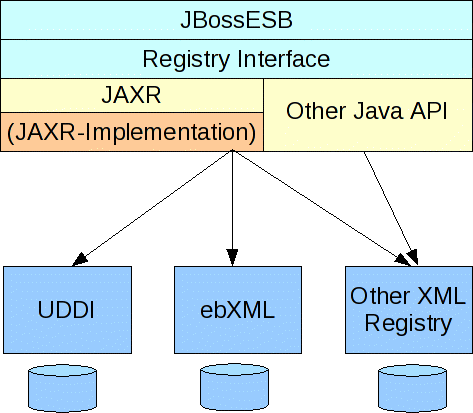
Figure 1. Blue print of
the Registry component architecture.
The Registry Implementation Class
Property:
org.jboss.soa.esb.registry.implementationClass
By
default we use the JAXR API. The JAXR API is a convenient API since
it allows us to connect any kind of XML based registry or
repository. However, if for example you want to use Systinet's Java
API you can do that by writing your own
SystinetRegistryImplemtation class and referencing it in this
property.
Using JAXR
Propery:
org.jboss.soa.esb.registry.factoryClass
If you
decided to use JAXR then you will have to pick which JAXR
implementation to use. This property is used to configure that
class. By default we use Scout and therefore it is set to the scout
factory 'org.apache.ws.scout.registry.ConnectionFactoryImpl'.
The next step is to tell the JAXR implementation the location of
the registry or repository for querying and updating, which is done
by setting the org.jboss.soa.esb.registry.queryManagerURI,
and org.jboss.soa.esb.registry.lifeCycleManagerURI
respectively, along with the username
(org.jboss.soa.esb.registry.user)
and password (org.jboss.soa.esb.registry.password)
for the UDDI.
Using Scout and
jUDDI
Property:
org.jboss.soa.esb.scout.proxy.transportClass
When
using Scout and jUDDI there is an additional parameter that one can
set. This is the transport class that should be used for
communication between Scout and jUDDI. Thus far there are 4
implementations of this class which are based on SOAP, SAAJ, RMI
and Local (embedded java). Note that when you change the transport,
you will also have to change the query and lifecycle URIs. For
example:
SOAP
queryManagerURI http://localhost:8080/juddi/inquiry
lifeCycleManagerURI http://localhost:8080/juddi/publish
transportClass org.apache.ws.scout.transport.AxisTransport
RMI
queryManagerURI jnp://localhost:1099/InquiryService?org.apache.juddi.registry.rmi.Inquiry#inquire
lifeCycleManagerURI jnp://localhost:1099/PublishService?org.apache.juddi.registry.rmi.Publish#publish
transportClass org.apache.ws.scout.transport.RMITransport
Local
queryManagerURI org.apache.juddi.registry.local.InquiryService#inquire
lifeCycleManagerURI org.apache.juddi.registry.local.PublishService#publish
transportClass org.apache.ws.scout.transport.LocalTransport
For
jUDDI we have two requirements that need to be fulfilled:
access
to the jUDDI database. You will need to create a schema in your
database, and add the jbossesb publisher. The
product/install/jUDDI-registry directory contains db create scripts
for you favorite database.
esb.juddi.xml.
The configuration of jUDDI itself. If you do not use a datasource
you need to take special care to set the following properties:
<entry key=”juddi.isUseDataSource”>false</entry>
<entry key=”juddi.jdbcDriver”>com.mysql.jdbc.Driver</entry>
<entry key=”juddi.jdbcUrl”>jdbc:mysql://localhost/juddi</entry>
<entry key=”juddi.jdbcUsername”>juddi</entry>
<entry key=”juddi.jdbcPassword”>juddi</entry>
if you do use a
datasource you need something like
<entry key=”juddi.isUseDataSource”>true</entry>
<entry key=”juddi.dataSource”>java:comp/env/jdbc/juddiDB</entry>
The
database can be automatically created if the user you have created
has enough rights to create tables. Next make sure the
isCreateDatabase flag is set to true, and that the sqlFiles
parameter settings point to the database you are using. The
jUDDI create scripts are located in the juddi.jar and jUDDI
supports daffodildb, db2, derby, firebird, hsqldb, informix,
jdatastore, mysql, oracle, postgresql, sybase (can be used for
ms-sqlserver) and totalxml.
<!-- <entry key=”juddi.tablePrefix”>JUDDI_</entry> -->
<entry key=”juddi.isCreateDatabase”>true</entry>
<entry key=”juddi.databaseExistsSql”>select * from ${prefix}BUSINESS_ENTITY
</entry>
<entry key=”juddi.sqlFiles”>
juddi-sql/mysql/create_database.sql,
juddi sql/mysql/insert_publishers.sql
</entry>
�
Chapter
3
Registry Configuration Examples
Introduction
As mentioned before, by
default the JBossESB is configured to use the JAXR API using Scout
as its implementation and jUDDI as the registry. Here are some
examples of how you can deploy this combo.
Embedded
All ESB components (with
components we really mean JVMs in this case) can embed the registry
and they all can connect to the same database (or different once if
that makes sense).
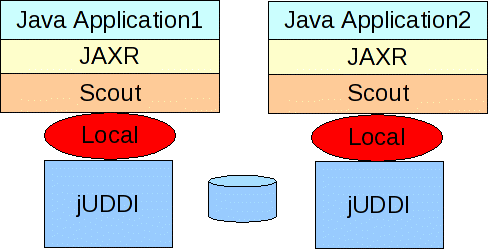
Figure 2. Embedded jUDDI.
Properties example:
<properties name="registry">
<property name="org.jboss.soa.esb.registry.implementationClass" value="org.jboss.internal.soa.esb.services.registry.JAXRRegistryImpl"/>
<property name="org.jboss.soa.esb.registry.factoryClass" value="org.apache.ws.scout.registry.ConnectionFactoryImpl"/>
<property name="org.jboss.soa.esb.registry.queryManagerURI" value="org.apache.juddi.registry.local.InquiryService#inquire"/>
<property name="org.jboss.soa.esb.registry.lifeCycleManagerURI" value="org.apache.juddi.registry.local.PublishService#publish"/>
<property name="org.jboss.soa.esb.registry.user" value="jbossesb"/>
<property name="org.jboss.soa.esb.registry.password" value="password"/>
<property name="org.jboss.soa.esb.scout.proxy.transportClass" value="org.apache.ws.scout.transport.LocalTransport"/>
</properties>
RMI using the juddi.war or
jbossesb.sar
Deploy
a version of the jUDDI that brings up an RMI service. The JBossESB
comes with a juddi.war in the product/install/jUDDI-registry
directory. This war brings up the regular webservices but also an
RMI service. Along with the juddi.war you need to deploy a
datasource which points to your jUDDI database. An example file is
supplied for MySQL.
The
jbossesb.sar also registers a RMI service. So you would only need to
deploy the juddi.war if you need webservice access
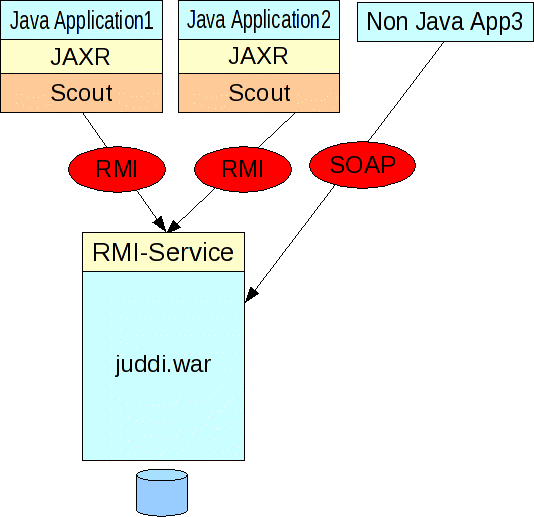
Figure 3. RMI using the
juddi.war
Properties example:
<properties name="registry">
<property name="org.jboss.soa.esb.registry.implementationClass" value="org.jboss.internal.soa.esb.services.registry.JAXRRegistryImpl"/>
<property name="org.jboss.soa.esb.registry.factoryClass" value="org.apache.ws.scout.registry.ConnectionFactoryImpl"/>
<property name="org.jboss.soa.esb.registry.queryManagerURI" value="jnp://localhost:1099/InquiryService?org.apache.juddi.registry.rmi.Inquiry#inquire"/>
<property name="org.jboss.soa.esb.registry.lifeCycleManagerURI" value="jnp://localhost:1099/PublishService?org.apache.juddi.registry.rmi.Publish#publish"/>
<property name="org.jboss.soa.esb.registry.user" value="jbossesb"/>
<property name="org.jboss.soa.esb.registry.password" value="password"/>
<property name="org.jboss.soa.esb.scout.proxy.transportClass" value="org.apache.ws.scout.transport.RMITransport"/>
</properties>
The
juddi.war is configured to bring up a RMI Service, which is
triggered by the following setting in the web.xml
<!-- uncomment if you want to enable making calls in juddi with rmi -->
<servlet>
<servlet-name>RegisterServicesWithJNDI</servlet-name>
<servlet-class>org.apache.juddi.registry.rmi.RegistrationService</servlet-class>
<load-on-startup>1</load-on-startup>
</servlet>
Make
sure to include, for example, the following JNDI settings in your
juddi.properties:
# JNDI settings (used by RMITransport)
java.naming.factory.initial=org.jnp.interfaces.NamingContextFactory
java.naming.provider.url=jnp://localhost:1099
java.naming.factory.url.pkgs=org.jboss.naming
The RMI
clients need to have the scout-client.jar in their classpath.
RMI using your own
JNDI Registration of the RMI Service
If
you don't want to deploy the juddi.war you can setup one of the ESB
components that runs in the the same JVM as jUDDI to register the
RMI service. While the other applications need to be configured to
use RMI.
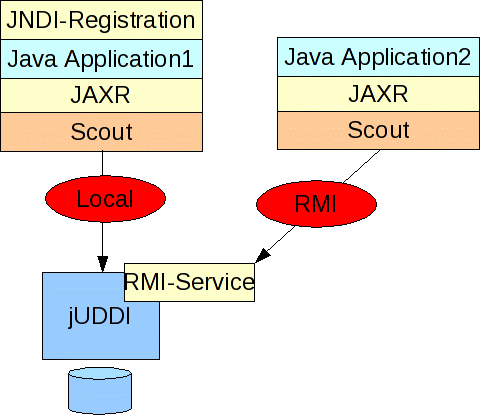
Figure 4. RMI using your
own JNDI registration
Properties example: For
application 1 you need the Local settings:
<properties name="registry">
<property name="org.jboss.soa.esb.registry.implementationClass" value="org.jboss.internal.soa.esb.services.registry.JAXRRegistryImpl"/>
<property name="org.jboss.soa.esb.registry.factoryClass" value="org.apache.ws.scout.registry.ConnectionFactoryImpl"/>
<property name="org.jboss.soa.esb.registry.queryManagerURI" value="org.apache.juddi.registry.local.InquiryService#inquire"/>
<property name="org.jboss.soa.esb.registry.lifeCycleManagerURI" value="org.apache.juddi.registry.local.PublishService#publish"/>
<property name="org.jboss.soa.esb.registry.user" value="jbossesb"/>
<property name="org.jboss.soa.esb.registry.password" value="password"/>
<property name="org.jboss.soa.esb.scout.proxy.transportClass" value="org.apache.ws.scout.transport.LocalTransport"/>
</properties>
while
for application2 you need the RMI settings:
<properties name="registry">
<property name="org.jboss.soa.esb.registry.implementationClass" value="org.jboss.internal.soa.esb.services.registry.JAXRRegistryImpl"/>
<property name="org.jboss.soa.esb.registry.factoryClass" value="org.apache.ws.scout.registry.ConnectionFactoryImpl"/>
<property name="org.jboss.soa.esb.registry.queryManagerURI" value="jnp://localhost:1099/InquiryService?org.apache.juddi.registry.rmi.Inquiry#inquire"/>
<property name="org.jboss.soa.esb.registry.lifeCycleManagerURI" value="jnp://localhost:1099/PublishService?org.apache.juddi.registry.rmi.Publish#publish"/>
<property name="org.jboss.soa.esb.registry.user" value="jbossesb"/>
<property name="org.jboss.soa.esb.registry.password" value="password"/>
<property name="org.jboss.soa.esb.scout.proxy.transportClass" value="org.apache.ws.scout.transport.RMITransport"/>
</properties>
Where the hostname of the
queryManagerURI and lifeCycleManagerURI need to point to the
hostname on which jUDDI is running (which would be where
application1 is running). Obviously application1 needs to have
access to a naming service. To do the registration process you need
to do something like:
//Getting the JNDI setting from the config
Properties env = new Properties();
env.setProperty(RegistryEngine.PROPNAME_JAVA_NAMING_FACTORY_INITIAL,factoryInitial);
env.setProperty(RegistryEngine.PROPNAME_JAVA_NAMING_PROVIDER_URL, providerURL);
env.setProperty(RegistryEngine.PROPNAME_JAVA_NAMING_FACTORY_URL_PKGS, factoryURLPkgs);
InitialContext context = new InitialContext(env);
Inquiry inquiry = new InquiryService();
log.info("Setting " + INQUIRY_SERVICE + ", " + inquiry.getClass().getName());
mInquery = inquiry;
context.bind(INQUIRY_SERVICE, inquiry);
Publish publish = new PublishService();
log.info("Setting " + PUBLISH_SERVICE + ", " + publish.getClass().getName());
mPublish = publish;
context.bind(PUBLISH_SERVICE, publish);
2.4 SOAP
Finally,
you can make the communication between Scout and jUDDI SOAP based.
Again you need to deploy the juddi.war and configure the
datasource. You probably want to shutdown the RMI service by
commenting out the RegisterServicesWithJNDI
servlet
in the web.xml.
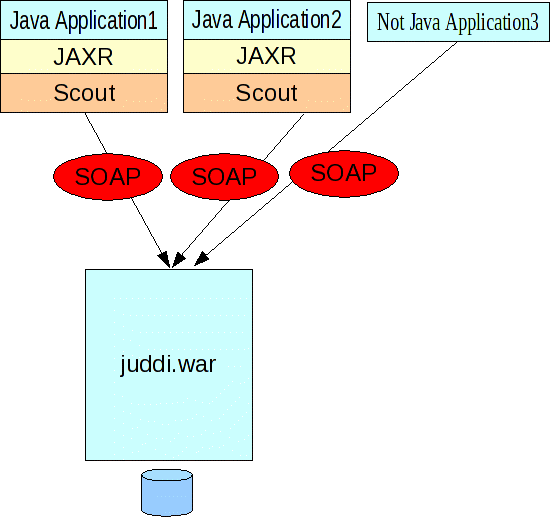
Figure 5. SOAP.
Properties example:
<properties name="registry">
<property name="org.jboss.soa.esb.registry.implementationClass" value="org.jboss.internal.soa.esb.services.registry.JAXRRegistryImpl"/>
<property name="org.jboss.soa.esb.registry.factoryClass" value="org.apache.ws.scout.registry.ConnectionFactoryImpl"/>
<property name="org.jboss.soa.esb.registry.queryManagerURI" value="http://localhost:8080/juddi/inquiry"/>
<property name="org.jboss.soa.esb.registry.lifeCycleManagerURI" value="http://localhost:8080/juddi/publish"/>
<property name="org.jboss.soa.esb.registry.user" value="jbossesb"/>
<property name="org.jboss.soa.esb.registry.password" value="password"/>
<property name="org.jboss.soa.esb.scout.proxy.transportClass" value="org.apache.ws.scout.transport.AxisTransport"/>
</properties>
JBossAS
4.2 ships with older versions of Scout and jUDDI. It is recommended
to remove the juddi.sar to prevent versioning issues.
�
Chapter 3
UDDI Browser
Introduction
We are looking for
a good web based console for jUDDI. In the meantime you can browse
the jUDDI registry using the uddibrowser. The uddibrowser 'ub' can
be downloaded from http://www.uddibrowser.org.
Before configuring the ub make sure the juddi.war is deployed to the
jbossesb.sar, to enable WS communication to jUDDI.
UB setup
The ub is a
standalone Java application. Start the ub and select Edit > UDDI
Registries, and add an entry called jUDDI
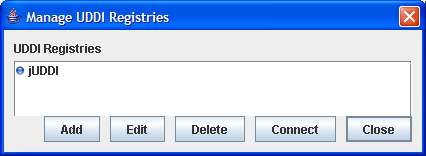
Figure 6. Add a
connection.
with settings
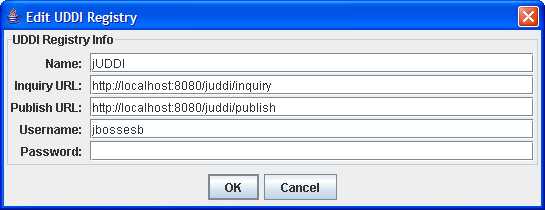
Figure 7. jUDDI connection
settings
Click on 'connect'
and select View > Find More > Find All Businesses
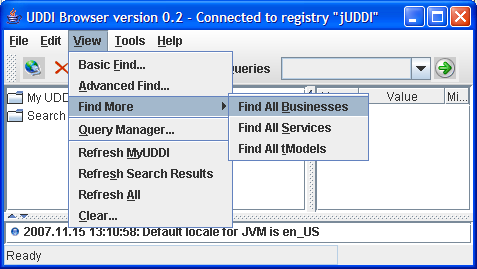
Figure 8. View all
Businesses.
and in the left
hand side you should see the Red Hat/JBossESB organization. You can
navigate into the individual services and their ServiceBindings.
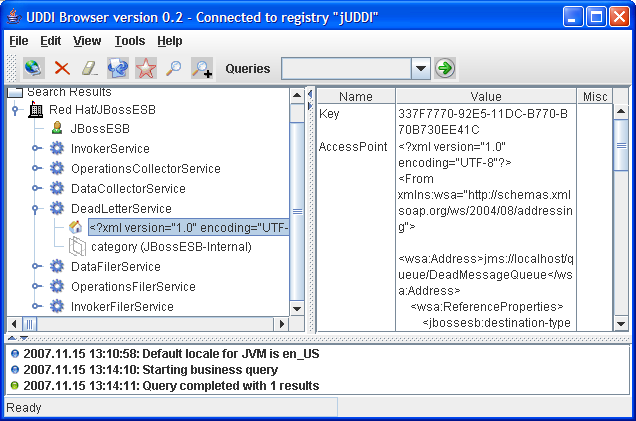
Figure 9. View Services
and ServiceBindings.
Each ServiceBinding
contains an EPR in its AccessPoint.
Some features of
the uddibrowser may not work, but it should give enough
functionality to maintain jUDDI. As mentioned before we are looking
for a good web based console for jUDDI.�
Chapter 4
Registry Troubleshooting
Scout and jUDDI
pitfalls
If
you use RMI you need the juddi-client.jar, which can be found as
part of the jUDDI distribution.
Make
sure the jbossesb-properties.xml file is on the classpath and read
or else the registry will try to instantiate classes with the name
of 'null'.
Make
sure you have a juddi.properties file on your classpath for jUDDI to
configure itself. JBossESB uses esb.juddi.xml, but generates the
esb.juddi.properties file for jUDDI to read.
Make
sure to read the README in the product/install/jUDDI-registry
directory, to prepopulate your own jUDDI database.
In
the event that a service fails or does not shut down cleanly, it is
possible that stale entries may persist within a registry. You will
have to remove these manually.
More Information
�
Chapter 4
What is a Rule
Service?
Introduction
The
JBoss ESB Rule Service allows you to deploy rules created in JBoss
Drools as services on the ESB. This is beneficial, because it means
you don't have to develop as much client code to integrate rules
into your application environment, and rules can be accessed as
part of an action chain or orchestrated business process. To
understand these types of services, you should first learn about
JBoss Drools.
Rule
Services are supported by the BusinessRulesProcessor action class
and the DroolsRuleService, which implement the RuleService
interface. While it is possible to use rule engines other than
JBoss Drools, only JBoss Drools is supported out the the box. The
BusinessRulesProcessor supports rules loaded from the classpath
that are defined in .drl files, .dsl files (domain specific
language support), and .xls (decision table support) files. These
are primarily for testing, prototypes, and very simple rule
services. There is no way to specify multiple rule files in the
jboss-esb.xml file, so complex rule services need to use the Drools
RuleAgent.
The
RuleService uses the RuleAgent to access rule packages from the
Drools BRMS or local file system. These rule packages can contain
thousands of rules, the source of which can be:
Drools
BRMS.
Imported
DRL files.
Rules
written in a Domain Specific Language.
Rules
from Decision Tables.
Use
of the Drools RuleAgent is the recommended approach for production
systems.
The
BusinessRulesProcessor action supports both Drools stateless and
stateful execution models. Most rule services will be stateless.
That is, a message will be sent to the rule service that includes
all the facts to be inserted into the rule engine in the message
body, the rules will execute, updating either the message and / or
the facts. Stateful execution takes place over time, with several
messages being sent to the rule service, the rules being executed
each time, the message and / or facts being updated each time, and
a final message that tells the rule service to dispose of the
stateful session working memory of the rule engine. There are
limitations in this configuration, namely that there can only be a
single (stateful) rule service in the message flow. This may change
in the future, when there are better ways to identify a stateful
conversation over the ESB.
�
Chapter 5
Rule Services using Drools
Introduction
The
Rule Service support in the JBossESB uses JBossRules/Drools as its
rule engine. JBossESB integrates with Drools through
The
BusinessRulesProcessor action class
Rules
written in Drools drl, dsl, decision table, or business rule editor.
The
ESB Message
The
ESB Message content, i.e., the objects in the message, which is the
data going into the rules engine (the “facts”).
When
a message is sent to the BusinessRulesProcessor, a certain rule set
will execute over the objects in the message, and update those
objects and / or the message.
Rule Set Creation
A
rule set can be created using the Red Hat Developer Studio which
includes a plug-in for JBoss Drools, or with Eclispe 3.3 and the
plugin installed (see Drools download site for the plugin). Since
the message is added as a global, you need to add
jbossesb-rosetta.jar to your Drools project.
You
can also write your rules using Drools BRMS business rule editor.
When using the Drools BRMS, it is not necessary to add the ESB
Message class to the imports, as long as jbossesb-rosetta.jar is
somewhere on the classpath of the BRMS web application.
For
a detailed discussion on rule creation and the Drools language
itself please see the Drools documention.
For
the most part, rules can be written without regard to their
deployment on the ESB as a service. There are a few caveats
however:
1)
All rules deployed as a rule service must define the ESBMessage as
a global, i.e.,
#declare
any global variables here
global
org.jboss.soa.esb.message.Message;
The
rationale for this is that most rule services will want to update
the message as a way of communicating results to other services in
the flow, so the BusinessRulesProcessor / DroolsRuleService will
always set the message as a global.
2)
The BusinessRulesProcessor / DroolsRuleService does not provide a
means to set globals in the jboss-esb.xml and have them set in
working memory. This would have made for additional configuration
support in the jboss-esb.xml, and could be supported in the future.
For now, if additional globals (other than the ESB Message) need to
be set, they can be done in higher salience rule. E.g.,
rule "Set
a global"
salience
100
when
then
drools.getWorkingMemory().setGlobal("foo",new
Foo());
end
3)
The DroolsRuleService does not provide a means to start a RuleFlow
from the rule service. This also would have made for additional
configuration support in the jboss-esb.xml, and could be supported
in the future. For now, if a RuleFlow needs to be started, this can
be done in higher salience rule. E.g.,
rule
"Start a ruleflow"
salience
100
when
then
drools.startProcess("processId");
end
Rule Service
Consumers
The
consumer of a rule service has little to worry about. In a rule
service environment there is no need for the consumer to worry
about creating rulebases, creating working memories, inserting
facts, or firing the rules. Instead the consumer just has to worry
about adding facts to the message, and possibly some properties to
the message.
In
some cases the client is ESB aware, and will add the objects to the
message directly:
MessageFactory
factory = MessageFactory.getInstance();
message =
factory.getMessage(MessageType.JAVA_SERIALIZED);
order = new Order();
order.setOrderId(0);
order.setQuantity(20);
order.setUnitPrice(new
Float("20.0"));
message.getBody().add("Order",
order);
In other cases the data
may be in an XML message, and a transformation service will be
added to the message flow to transform the XML to POJOs before the
rule service is invoked.
Using
stateful rule execution requires a few properties to be added the
messages. For the first message,
message.getProperties().setProperty("dispose",
false);
message.getProperties().setProperty("continue",
false); // this is the default
For
all the subsequest messages but the final message,
message.getProperties().setProperty("dispose",
false);
message.getProperties().setProperty("continue",
true);
For
the final message,
message.getProperties().setProperty("dispose",
true); // this is the default
message.getProperties().setProperty("continue",
true);
These
can be added directly by an ESB aware client. A non-ESB aware
client would have to communicate the position of the message
(first, ongoing, last) in the data, and an action class would need
to be added to the pipeline to add the properties to the ESB
message (see quickstarts/business_ruleservice_stateful for an
example of this type of service).
Configuration
Configuration
of a rule service is in the jboss-esb action element for the
service. Several configuration parameters are required or optional
The
action class and name is required:
<action
class="org.jboss.soa.esb.actions.BusinessRulesProcessor"
name="OrderDiscountRuleService">
This
configures the action class and its name. The name is user defined.
One
of the following is also required
<property name="ruleSet" value="drl/OrderDiscount.drl"
/>
for
specifying a drl file, or
<property
name="ruleSet" value="dsl/approval.dslr" />
<property
name="ruleLanguage" value="dsl/acme.dsl" />
for
specifying a dsl and dslr (domain specific language) files , or
<property
name="decisionTable" value="PolicyPricing.xls" />
for
specifying a decisionTable on the classpath, or
<property
name="ruleAgentProperties" value="brmsdeployedrules.properties"
/>
for
specifying a properties file on the classpath that tells the rule
agent how to find the rule package. This could specify a url or a
local file system.
Several
example configurations follow:
Example
1: Rules are in a drl, execution is stateless.
<action
class="org.jboss.soa.esb.actions.BusinessRulesProcessor"
name="OrderDiscountRuleService"
<property
name="ruleSet"
value="drl/OrderDiscount.drl"
/>
<property
name="ruleReload" value="true" />
<property
name="object-paths">
<object-path
esb="body.Order" />
</property>
</action>
Example
2: Rules are in a drl, execution is stateful.
In
this scenario, a service may receive multiple messages over time
and wish to use rules to accumulate data across this message set.
Each time a message is received, the rules will be fired within the
context of a single Stateful Session. The active Session can be
disposed of (reset) via the “dispose” property.
NOTES:
A
single, synchronized Session instance is shared across all
concurrent executions of a Stateful Session deployments. This
greatly limits the type of usecase for which the Stateful deployment
model is applicable. If multiple, client oriented sessions are
required per Service deployment, consider using a jBPM/BPEL
solution.
Stateful
Sessions are not persistent and are therefore volatile in nature.
Stateful
Sessions are not clustered.
<action
class="org.jboss.soa.esb.actions.BusinessRulesProcessor"
name="OrderDiscountMultipleRuleServiceStateful">
<property
name="ruleSet"
value="drl/OrderDiscountOnMultipleOrders.drl"
/>
<property
name="ruleReload" value="false" />
<property
name="stateful" value="true" >
<property
name="object-paths">
<object-path
esb="body.Customer" />
<object-path
esb="body.Order" />
</property>
</action>
Example 3: Rules are in a Domain Specific Language, execution is
stateless.
<action
class="org.jboss.soa.esb.actions.BusinessRulesProcessor"
name="PolicyApprovalRuleService"
<property
name="ruleSet" value="dsl/approval.dslr" />
<property
name="ruleLanguage" value="dsl/acme.dsl" />
<property
name="ruleReload" value="true" />
<property
name="object-paths">
<object-path
esb="body.Driver" />
<object-path
esb="body.Policy" />
</property>
</action>
Example
4: Rules are in a DecisionTable, execution is stateless.
<action
class="org.jboss.soa.esb.actions.BusinessRulesProcessor"
name="PolicyPricingRuleService"
<property
name="decisionTable"
value="decisionTable/PolicyPricing.xls"
/>
<property
name="ruleReload" value="true" />
<property
name="object-paths">
<object-path
esb="body.Driver" />
<object-path
esb="body.Policy" />
</property>
</action>
Example
5: Rules are in the BRMS, execution is stateless.
<action
class="org.jboss.soa.esb.actions.BusinessRulesProcessor"
name="RuleAgentPolicyService"
<property
name="ruleAgentProperties"
value="ruleAgent/brmsdeployedrules.properties"
/>
<property
name="object-paths">
<object-path
esb="body.Driver" />
<object-path
esb="body.Policy" />
</property>
</action>
The
action attributes to the action tag are show in Table 1. The
attributes specify which action is to be used and which name this
action is to be given.
|
Attribute |
Description |
|
Class |
Action class, :
org.jboss.soa.esb.actions.BusinessRulesProcessor |
|
Name |
Custom
action name |
Table
1. BusinessRulesProcessor action configuration attributes.
The
action properties are shown in Table 2. The properties specify the
set of rules (ruleSet) to be used in this action.
|
Property |
Description |
|
ruleSet |
Optional
reference to a file containing the Drools ruleSet. The set of
rules that is used to evaluate the content. Only 1 ruleSet can be
given for each rule service instance. |
|
ruleLanguage |
Optional
reference to a file containing the definition of a Domain
Specific Language to be used for evaluating the rule set. If this
is used, the file in ruleSet should be a dslr file. |
|
ruleReload |
Optional
property which can be to true to enable 'hot' redeployment of
rule sets. Note that this feature will cause some overhead on the
rules processing. Note that rules will also reload if the .esb
archive in which they live is redeployed. |
|
decisionTable |
Optional
reference to a file containing the definition of a spreadsheet
containing rules.
|
|
ruleAgentProperties |
Optional
reference to a properties file containing the location (URL or
file path) to the compiled rule package(s). Note there is no need
to specify ruleReload with a ruleAgent, since this is controlled
through the properties file. |
|
Stateful |
Optional
property which can be to true to specify that the rule service
will receive multiple messages over time that will add fact to
the rule engine working memory and re-execute the rules.
NOTE:
A single shared session is shared across all Service executions.
|
|
|
|
|
object-paths |
Optional
property to pass Message objects into Drools WorkingMemory. |
Table
2. BusinessRulesProcessor action configuration properties.
Object Paths
Note
that Drools treats objects as shallow objects to achieve highly
optimized performance, so what if you want to evaluate an object
deeper in the object tree? An the optional 'object-paths' property
can be used, which results in the extraction of objects from the
message, using an “ESB Message Object Path”. MVEL is used to
extract the object and the path used should follow the syntax:
location.objectname.[beanname].[beanname]...
where,
location
: one of {body, header, properties, attachment}
objectname:
name of the object name, attachments can be named or numbered, so
for attachments this can be a number too.
beannames:
optionally you traverse a bean graph by specifying bean names
examples
:
properties.Order,
gets the property object named "Order"
attachment.1,
gets the first attachment Object
attachment.FirstAttachment,
gets the attachment named 'FirstAttachment'
attachment.1.Order,
gets getOrder() return object on the attached Object.
body.Order1.lineitem,
obtains the object named "Order1" from the body of the
message. Next it will call getLineitem() on this object. More
elements can be added to the query to traverse the bean graph.
It
is important to remember that you have to add java import
statements on the objects you import into your rule set.
Finally,
the Object Mapper can flatten out entire collections. For example a
collectoin Orders will be unrolled, and each order object inserted
into working memory.
Deployment and
Packaging
It
is recommended that you package up your code into units of
functionality, using .esb packages. The idea is to package up your
routing rules alongside the rule services that use the rule sets.
Figure 3 shows a layout of the business_rules_service quickstart to
demonstrate a typical package.
.Quickstart_business_rules_service.esb
| jbm-queue-service.xml
| MyBusinessRules.drl
| MyBusinessRulesDiscount.drl
| MyRoutingRules.drl
| smooks-res.xml
|
+---META-INF
| deployment.xml
| jboss-esb.xml
| MANIFEST.MF
|
\---org
\---jboss
\---soa
\---esb
\---dvdstore
| Customer.class
| OrderHeader.class
| OrderItem.class
\---samples
\---quickstart
\---businessrules
| ReviewMessage.class
\---test
SendJMSMessage.class
Figure 3. Typical .esb
archive which uses Drools.
Finally
make sure to deploy and reference the jbrules.esb in your
deployment.xml.
<jbossesb-deployment>
<depends>jboss.esb:deployment=jbrules.esb</depends>
</jbossesb-deployment>�
Chapter 6
What is Content-Based
Routing?
Introduction
Typically,
information within the ESB is conveniently packaged, transferred,
and stored in the form of a message. Messages are addressed to
Endpoint References (services or clients), that identify the
machine/process/object that will ultimately deal with the content
of the message. However, what happens if the specified address is
no longer valid? For example, the service has failed or been
removed from service? It is also possible that the service no
longer deals with messages of that particular type; in which case,
presumably some other service still handles the original function,
but how should the message be handled? What if other services
besides the intended recipient are interested in the message's
content? What if no destination is specified?
One
possible solution to these problems is Content-Based Routing.
Content-based routing seeks to route messages, not by a specified
destination, but by the actual content of the message itself. In a
typical application, a message is routed by opening it up and
applying a set of rules to its content to determine the parties
interested in its content.
The
ESB can determine the destination of a given message based on the
content of that message, freeing the sending application from
having to know anything about where a message is going to end up.
Content-based
routing and filtering networks are extremely flexible and very
powerful. When built upon established technologies such as MOM
(Message Oriented Middleware), JMS (Java Message Services), and XML
(Extensible Markup Language) they are also reasonably easy to
implement.
Simple example
Content-based
routing systems are typically built around two types of entities:
routers
(of which there may be only one) and services
(of which there is usually more than one). Services
are the ultimate consumers of messages. How services publish their
interest in specific types of messages with the routers is
implementation dependent, but some mapping must exist between
message type (or some aspect of the message content) and services
in order for the router to direct the flow of incoming messages.
Routers,
as their name suggests, route messages. They examine the content of
the messages they receive, apply rules to that content, and forward
the messages as the rules dictate.
In
addition to routers and services, some systems may also include
harvesters,
which
specialize in finding interesting information, packaging it up as a
formatted message before
sending it to a router. Harvesters mine many sources of
information including mail transfer agent message stores, news
servers, databases and other legacy systems.
The
diagram below illustrates a typical CBR architecture using an ESB.
At the heart of the system, represented by the cloud, is the ESB.
Messages are sent from the client into the ESB, which directs them
to the Router. This is then responsible for sending the messages to
their ultimate destination (or destinations, as shown in this
example).
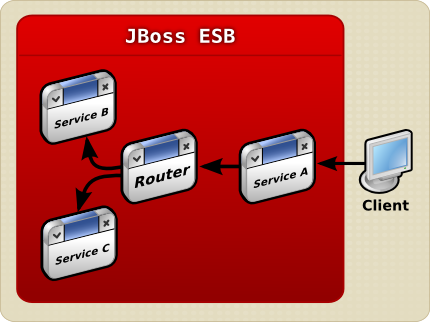
�
Chapter 7
Content Based Routing using Drools
Introduction
The
Content Based Router (CBR) in the JBossESB uses JBossRules/Drools
as its evaluation engine. JBossESB integrates with Drools through
three
different routing action classes,
a
routing rule set, written in Drools drl (and optionally dsl)
language.
The
ESB Message content, either the serialized XML, or objects in the
message, which is the data going into the rules engine.
destination(s)
which is the result coming out of the rules engine.
When
a message gets sent to the CBR, a certain rule set will evaluate
the message content and return a set of Service destinations. We
discuss how a target rule set can be targeted, how the message
content is evaluated and what is done with the destination results.
Three different
routing action classes
JBossESB
ships with three slightly different routing action classes. Each of
these action classes implements an Enterprise Integration Pattern.
For more information of the Enterprise Integration Pattern you can
check the JBossESB
Wiki. The following actions are supported:
org.jboss.soa.esb.actions.ContentBasedRouter
Implements
the Content Based Routing pattern. It routes a message to one or
more destination services based on the message content and the rule
set it is evaluating it against. The CBR throws an exception when
no destinations are matched for a given rule set/message
combination. This action will terminate any further pipeline
processing, so it should be the last action of your pipeline.
org.jboss.soa.esb.actions.ContentBasedWireTap
Implements
the WireTap pattern. The WireTap is an Enterprise Integration
Pattern (EIP) where a copy of the message is send to a control
channel. The CBR-WT is identical in functionality to the
ContentBasedRouter, however it does not terminate the
pipeline which makes it suitable to be used as a WireTap.
org.jboss.soa.esb.actions.MessageFilter.
Implements
the Message-Filter pattern. The Message Filter pattern represents
the case where messages can simply be dropped if certain content
requirements are not met. The CBR-MF is identical in functionality
to the ContentBasedRouter, but it does not throw an
exception if the rule set does not match any destinations. In this
case the message is simply filter out.
Rule Set Creation
A
rule set can be created using the JBossIDE or Red Hat Developer
Studio which includes a plug-in for JBossRules. Figure 1 shows a
screen shot of the plug-in. For a detailed discussion on rule
creation and the Drools language itself please see the Drools
documention. To turn a regular ruleSet into a Countent Based
Routing RuleSet you must be evaluating an EsbMessage and the rule
match should result in a List of Strings containing the service
destination names. To do this you need to make sure you remember
two things:
your
rule set imports the EsbMessage
import
org.jboss.soa.esb.message.Message
and
your rule set defines
global
java.util.List destinations;
which
will make the list of destinations available to the ESB
Figure 1.
Create a new ruleSet using JbossIDE or Red Hat Developer Studio
The
message will be asserted into the working memory of the rules
engine. Figure 2 shows an example where the MessageType is used to
determine to which destination the Message is going to be send.
This particular ruleSet is shipped in the JBossESBRules.drl file
and the rule checks if the type is XML or Serializable.
XPath Domain
Specific Language
For
XML-based messages it is convenient to do XPath based evaluation.
To support this we ship a “Domain Specific Language”
implementation which allows us to use XPath expressions in the rule
file. defined in the XPathLanguage.dsl. To use it you need to
reference it in your ruleSet with:
expander
XPathLanguage.dsl
Currently
the XPath Language makes sure the message is of the type JBOSS_XML
and it defines
xpathMatch
“<element>”: yields true if an element by this name is
matched.
xpathEquals
“<element>”, “<value>”: yields true if the
element is found and it's value equals the value.
xpathGreaterThan
“<element>”, “<value>”: yields true if the
element is found and it's value is greater than the value.
xpathLowerThan
“<element>”, “<value>”: yields true if the
element is found and it's value is lower then the value.
XPath and
namespaces
To use
namespaces with XPath, one needs to specify which namespace
prefixes are to be used in the XPath expression. The namespace
prefixes are specified as a comma separated list like this:
“prefix=uri,prefix=uri”. This can be accomplished for all the
above types of XPath expressions:
xpathMatch
expr “<expression>” use namespaces “<namepaces>”
xpathEquals
expr “<expression>”, “<value>” use namespaces
“<namspaces>”
xpathGreaterThan
“<expression>”, “<value>” use namespaces
“<namspaces>”
xpathLowerThan
expr “<expression>, “<value> use namespaces
“<namespaces>
Notice
that the namespace aware statements differ in that they need the
extra “expr” in front of the XPath expression. This is
do avoid colliding with the non XPath aware statements in the dsl
file.
Also
note that the prefixes do not have to match those used in the xml
to be evaluated, it only matters that the URI is the same.
The
XPathLanguage.dsl is defined in a file called XPathLanguage.dsl,
and can be customized if needed, or you can define your own DSL
altogether. The Quickstart called fun_cbr
demonstrates this use of XPath.
Configuration
Now
that we have seen all the individual pieces how does it all tie
together? It basically all comes down to configuration at this
point, which is all done in your jboss-esb.xml. Figure 1 shows a
service configuration fragment. In this fragment the service is
listening on a JMS queue.
Each
EsbMessage is passed on to in this case the ContentBasedRouter
action class which is loaded with a certain rule set. It sets the
EsbMessage into Working Memory, fires the rules, obtains the list
of destinations and routes copies of the EsbMessage to these
services. It uses the rule set JbossESBRules.drl, which matches two
destinations, name 'xml-destination' and 'serialized-destination'.
These names are mapped to real service names in the 'route-to'
section.
<service
category="MessageRouting"
name="YourServiceName"
description="CBR Service">
<listeners>
<jms-listener name="CBR-Listener"
busidref="QueueA" maxThreads="1">
</jms-listener>
</listeners>
<actions>
<action class="org.jboss.soa.esb.actions.ContentBasedRouter" name="YourActionName">
<property name="ruleSet" value="JBossESBRules.drl"/>
<property name="ruleReload" value="true"/>
<property name="destinations">
<route-to destination-name="xml-destination"
service-category="category01"
service-name="jbossesbtest1" />
<route-to destination-name="serialized-destination" service-category="category02"
service-name="jbossesbtest2" />
</property>
<property name="object-paths">
<object-path esb="body.test1" />
<object-path esb="body.test2" />
</property>
</action>
</actions>
</service>
Figure 2. Example Content
Based Routing Service configuration.
The
action attributes to the action tag are show in Table 1. The
attributes specify which action is to be used and which name this
action is to be given.
|
Attribute |
Description |
|
Class |
Action class,
one of :
org.jboss.soa.esb.actions.ContentBasedRouter
org.jboss.soa.esb.actions.ContentBasedWireTap
org.jboss.soa.esb.actions.MessageFilter |
|
Name |
Custom
action name |
Table
1. CBR action configuration attributes.
The
action properties are shown in Table 2. The properties specify the
set of rules (ruleSet) to be used in this action.
|
Property |
Description |
|
ruleSet |
Name of
the filename containing the Drools ruleSet. The set of rules that
is used to evaluate the content. Only 1 ruleSet can be given for
each CBR instance. |
|
ruleLanguage |
Optional
reference to a file containing the definition of a Domain
Specific Language to be used for evaluating the rule set. |
|
ruleAgentProperties |
This
property points to a rule agent properties file located on the
classpath. The properties file can contain a property that points
to precompiled rules packages on the file system, in a directory,
or identified by an URL for integration with the BRMS. See the
“RuleAgent” section below for more information. |
|
ruleReload |
Optional
property which can be to true to enable 'hot' redeployment of
rule sets. Note that this feature will cause some overhead on the
rules processing. Note that rules will also reload if the .esb
archive in which they live is redeployed. |
|
stateful |
Optional property
which tells the RuleService to use a stateful session where facts
will be remembered between invokations. See the “Stateful
Rules” section for more information about stateful rules. |
|
destinations |
A set of
route-to properties each containing the logical name of the
destination along with the Service category and name as
referenced in the registry. The logical name is the name which
should be used in the rule set. |
|
object-paths |
Optional
property to pass Message objects into Drools WorkingMemory. |
Table
2. CBR action configuration properties.
Object Paths
Note
that Drools treats objects as shallow objects to achieve highly
optimized performance, so what if you want to evaluate an object
deeper in the object tree? An optional 'object-paths' property can
be used, which results in the extraction of objects from the
message, using an “ESB Message Object Path”. MVEL is used to
extract the object and the path used should follow the syntax:
location.objectname.[beanname].[beanname]...
where,
location
: one of {body, header, properties, attachment}
objectname:
name of the object name, attachments can be named or numbered, so
for attachments this can be a number too.
beannames:
optionally you traverse a bean graph by specifying bean names
examples
:
properties.Order,
gets the property object named "Order"
attachment.1,
gets the first attachment Object
attachment.FirstAttachment,
gets the attachment named 'FirstAttachment'
attachment.1.Order,
gets getOrder() return object on the attached Object.
body.Order1.lineitem,
obtains the object named "Order1" from the body of the
message. Next it will call getLineitem() on this object. More
elements can be added to the query to traverse the bean graph.
It
is important to remember that you have to add java import
statements on the objects you import into your rule set. Finally,
the Object Mapper cannot flatten out entire collections, so if you
need to do that you have to perform a (Smooks-) transformation on
the message first, to unroll the collection.
Stateful Rules
Using
stateful sessions means that facts will be remembered across
invocations. When stateful is set to true the working memory will
not be disposed.
Stateful
rule services must be told via message properties when to continue
with a current stateful session and when to dispose of it. To
signal that you want to continue an existing stateful session two
message properties must be set :
message.getProperties().setProperty(“dispose”, false);
message.getProperties().setProperty(“continue”, true);
When you invoke the rules
for the last time you must set “dispose” to true so that the
working memory is disposed:
message.getProperties().setProperty(“dispose”, true);
message.getProperties().setProperty(“continue”, true);
For more details about
the RuleService please see RuleService
chapter.
For an
example of using stateful rules take a look at the
business_ruleservice_stateful quickstart.
NOTES:
A
single, synchronized Session instance is shared across all
concurrent executions of a Stateful Session deployments. This
greatly limits the type of usecase for which the Stateful deployment
model is applicable. If multiple, client oriented sessions are
required per Service deployment, consider using a jBPM/BPEL
solution.
Stateful
Sessions are not persistent and are therefore volatile in nature.
Stateful
Sessions are not clustered.
RuleAgent
By
using the rule agent property you can use precompiled rules
packages that can be located on the local file system, in a local
directory, or point to an URL. For information about the
configuration options that exist for the properties file please
refer to section 9.4.4.1.
The Rule Agent of the Drools manual.
For
more details about the RuleService please see RuleService
chapter.
For an
example of using a rule agent take a look at the
business_ruleservice_ruleAgent quickstart.
RuleAgent and
Business Rule Management System
By
using the rule agent property you can effectively integrate your
service with a Business Rule Management System (BRMS). This can be
accomplished by specifying a URL in the rule agent properties file.
For information about the how to configure the URL and the other
properties please refer to section 9.4.4.1.
The Rule Agent of the Drools manual.
For
more details about the RuleService please see RuleService
chapter.
For
information about the how to install and configure the BRMS please
refer to the chapter Chapter
9 of the Drools manual.
Executing Business Rules
Related
to rule execution for routing is the rule execution to simply
modifying data in the message according to business rules.
An example Quickstart called business_rule_service demonstrates
this use case. This quickstart uses the action class
org.jboss.soa.esb.actions.BusinessRulesProcessor
The
functionality of the Business Rule Processor (BRP) is identical to
the Content Based Router, but it does not do any routing,
instead it returns the modified EsbMessage for further action
pipeline processing. You may mix business and routing rules in one
rule set if you wish to do so, but routing will only occur if you
use one of the three routing action classes mentioned earlier.
Changing
RuleService implementations
If
you would like to use a different RuleService then the default one
that is shipped with JBossESB, then this is possible by specifying
the class you would like to use in the action configuration:
<property name="ruleServiceImplClass" value="org.com.YourRuleService" />
The requirement is that
your rule service implements the interface:
org.jboss.soa.esb.services.rules.RuleService.
Deployment and
Packaging
It
is recommended that you package up your code into units of
functionality, using .esb packages. The idea is to package up your
routing rules alongside the rule services that use the rule sets.
Figure 3 shows a layout of the simple_cbr quickstart to demonstrate
a typical package.
simple_cbr.esb
| jbm-queue-service.xml
| SimpleCBRRules-XPath.drl
| SimpleCBRRules.drl
|
+---META-INF
| deployment.xml
| jboss-esb.xml
| MANIFEST.MF
|
\---org
\---jboss
\---soa
\---esb
\---samples
\---quickstart
\---simplecbr
| MyJMSListenerAction.class
| ReturnJMSMessage.class
| RouteExpressShipping.class
| RouteNormalShipping.class
|
\---test
ReceiveJMSMessage$1.class
ReceiveJMSMessage.class
SendJMSMessage.class
Figure 3. Typical .esb
archive which uses Drools.
Finally
make sure to deploy and reference the jbrules.esb in your
deployment.xml.
<jbossesb-deployment>
<depends>jboss.esb:deployment=jbrules.esb</depends>
</jbossesb-deployment>�
Chapter 8
Content Based Routing using Smooks
Introduction
The
SmooksAction can be used for splitting HUGE messages into split
fragments and performing Content-Based Routing on these split
fragments.
An
example of this might be a huge order message with
thousands/millions of order items per message. You might need to
split the order up by order item and route each order item split
fragment to one or more destinations based on the fragment content.
This example can be illustrated as follows:
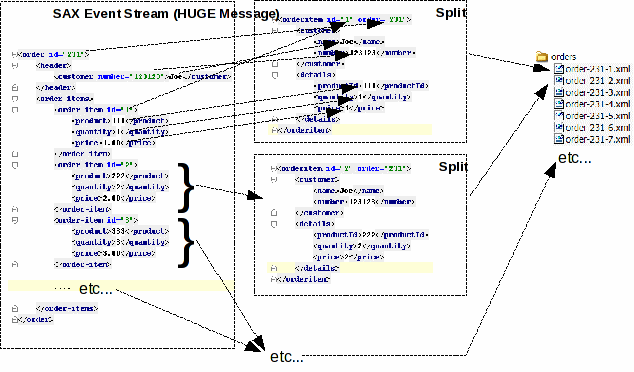
The
above illustration shows how we would like to perform the
by-order-item splitting operation and route the split messages to
file. The split messages contain a full XML document with data
merged from the order header and the order item in question i.e.
not just a dumb split. In this illustration, we simply route all
the message fragments to file, but with the Smooks Action, we can
also route the fragment messages to JMS and to a Database and in
different formats (EDI, populated Java Objects, etc).
The
Smooks configuration for the above example would look as follows.
(1) <jb:bindings beanId="order" class="java.util.HashMap" createOnElement="order">
<jb:value property="orderId" decoder="Integer" data="order/@id"/>
<jb:value property="customerNumber" decoder="Long" data="header/customer/@number"/>
<jb:value property="customerName" data="header/customer"/>
<jb:wiring property="orderItem" beanIdRef="orderItem"/>
</jb:bindings>
(2) <jb:bindings beanId="orderItem" class="java.util.HashMap" createOnElement="order-item">
<jb:value property="itemId" decoder="Integer" data="order-item/@id"/>
<jb:value property="productId" decoder="Long" data="order-item/product"/>
<jb:value property="quantity" decoder="Integer" data="order-item/quantity"/>
<jb:value property="price" decoder="Double" data="order-item/price"/>
</jb:bindings>
(3) <file:outputStream openOnElement="order-item" resourceName="orderItemSplitStream">
<file:fileNamePattern>
order-${order.orderId}-${order.orderItem.itemId}.xml
</file:fileNamePattern>
<file:destinationDirectoryPattern>target/orders</file:destinationDirectoryPattern>
<file:listFileNamePattern>order-${order.orderId}.lst</file:listFileNamePattern>
<file:highWaterMark mark="3"/>
</file:outputStream>
(4) <ftl:freemarker applyOnElement="order-item">
<ftl:template>target/classes/orderitem-split.ftl</ftl:template>
<ftl:use>
<ftl:outputTo outputStreamResource="orderItemSplitStream"/>
</ftl:use>
</ftl:freemarker>
Resource
configurations #1 and #2 are there to bind data from the source
message into Java Objects in the Smooks bean context. In this
case, we're just binding the data into HashMaps. The Map being
populated in configuration #2 is recreated and repopulated for
every order item as the message is being filtered. The populated
Java Objects (from resources #1 and #2) are used to populate a
FreeMarker template (resource #4), which gets applied on every
order item, with the result of the templating operation being
output to a File OutputStream (resource #3). The File OutputStream
(resource #3) also gets applied on every order item, managing the
file output for the split messages.
What
the above does not show is how to perform the content based routing
using <condition> elements on the resources. It also doesn't
demonstrate how to route fragments to to message aware endpoints.
We will be adding a quickstart dedicated to demoing these features
of the ESB. Check the User Forum for details.
JBoss ESB 4.6 upgrades
to Smooks v1.1, which means that the split described above can be
done without having to define the binding configurations (#1 and
#2). For more on how to do this, see the documentation on
“FreeMarker Transforms using NodeModels” in section 4 of the
Smooks
User Guide.
�
Chapter 9
Message Transformation
Overview
JBoss
ESB supports message data transformation through a number of
mechanisms:
Smooks:
Smooks
is, among other things, a Fragment based Data Transformation and
Analysis tool (XML, EID, CSV, Java etc). It supports a wide range
of data processing and manipulation features
XSLT:
JBoss ESB supports message transformation through the standard XSLT
usage model, as well as through the Smooks.
ActionProcessor
Data Transformation:
Where Smooks
can not handle a specific transformation usecase, you can implement
a custom transformation solution through implementation of the
org.jboss.soa.esb.actions.ActionProcessor
interface.
Smooks
Message
Transformation on JBossESB
is supported by the SmooksAction component. This is an ESB Action
component that allows the Smooks
Data Transformation/Processing Framework to be plugged into an ESB
Action Processing Pipeline.
A wide
range of source (XML, CSV, EDI, Java etc) and target (XML, Java,
CSV, EDI etc) data formats are supported by the SmooksAction
component. A wide range of Transformation Technologies are also
supported, all within a single framework. See the Message Action
Guide for more details.
Samples &
Tutorials
A number
of Transformation Quickstart samples accompany the JBossESB
distribution. Check out the "transform_*" Quickstarts.
A number
of tutorials are available online on the Smooks
website. Any of these samples can be easily ported to JBossESB.
�
XSL
Transformations
XSLT
transformation are supported by the XstlAction. Please see the
section “XSLTAction” in the ProgrammersGuide for more
information.
�
Chapter 10
jBPM Integration
Introduction
JBoss jBPM is a powerful
workflow and BPM (Business Process Management) engine. It enables
the creation of business processes that coordinate between people,
applications and services. With its modular architecture, JBoss
jBPM combines easy development of workflow applications with a
flexible and scalable process engine. The JBoss jBPM process
designer graphically represents the business process steps to
facilitate a strong link between the business analyst and the
technical developer. This document assumes that you are familiar
with jBPM. If you are not you should read the jBPM documentation [TB-JBPM-USER]
first. JBossESB integrates the jBPM so that it can be used for two
purposes:
Service Orchestration:
ESB services can be orchestrated using jBPM. You can create a jBPM
process definition which makes calls into ESB services.
Human
Task Management :
jBPM allows you to incorporate
human task management integrated with machine based services.
Integration
Configuration
The
jbpm.esb deployment that ships with the ESB includes the full jBPM
runtime and the jBPM console. The runtime and the console share a
common jBPM database. The ESB DatabaseInitializer mbean creates
this database on startup. The configuration for this mbean is found
in the file jbpm.esb/jbpm-service.xml.
<classpath
codebase="deploy" archives="jbpm.esb"/>
<classpath
codebase="deploy/jbossesb.sar/lib"
archives="jbossesb-rosetta.jar"/>
<mbean
code=
"org.jboss.internal.soa.esb.dependencies.DatabaseInitializer"
name="jboss.esb:service=JBPMDatabaseInitializer">
<attribute
name="Datasource">java:/JbpmDS</attribute>
<attribute
name="ExistsSql">
select
* from JBPM_ID_USER</attribute>
<attribute
name="SqlFiles">
jbpm-sql/jbpm.jpdl.hsqldb.sql,jbpm-sql/import.sql
</attribute>
<depends>
jboss.jca:service=DataSourceBinding,name=JbpmDS
</depends>
</mbean>
<mbean
code=
"org.jboss.soa.esb.services.jbpm.configuration.JbpmService"
name="jboss.esb:service=JbpmService">
</mbean>
The
first Mbean configuration element contains the configuration for
the DatabaseInitializer. By default the attributes are configured
as follows:
“Datasource” - use a
datasource called JbpmDS,
“ExistsSql” - check if
the database exists by running the sql: “Select * from
JBPM_ID_USER”
“SqlFiles” - if the
database does not exist it will attempt to run the files
jbpm.jpdl.hsqldb.sql and import.sql. These files reside in the
jbpm.esb/jbpm-sql directory and can be modified if needed. Note that
slightly different ddl files are provided for the various databases.
The
DatabaseInitializer mbean is configured in jbpm-service.xml to wait
for the JbpmDS to be deployed, before deploying itself. The second
mbean “JbpmService” ties the lifecycle of the jBPM job executor
to the jbpm.esb lifecycle - it starts a job executor instance on
startup and stops it on shutdown. The JbpmDS datasource is defined
in the jbpm-ds.xml and by default it uses a HSQL database. In
production you will want change to a production strength database.
All jbpm.esb deployments should share the same database instance
so that the various ESB nodes have access to the same processes
definitions and instances.
The
jBPM console is a web application accessible at
http://localhost:8080/jbpm-console
when you start the server. The login screen is shown in Fig. 1.
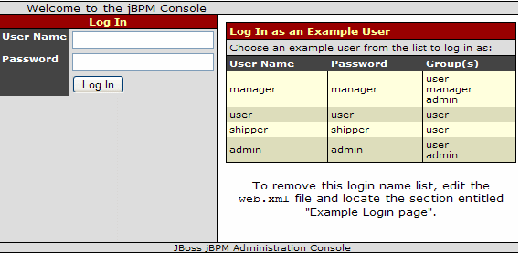
Figure
1. The jBPM Console
Please
check the jBPM documentation [TB-JBPM-USER] to change the security
settings for this application, which will involve change some
settings in the conf/login-config.xml. The console can be used for
deploying and monitoring jBPM processes, but is can also be used
for human task management. For the different users a customized
task list will be shown and they can work on these tasks. The
quickstart bpm_orchestration4 [JBESB-QS] demonstrates this feature.
The
jbpm.esb/META-INF directory contains the deployment.xml and the
jboss-esb.xml. The deployment.xml specifies the resources this esb
archive depends on:
<jbossesb-deployment>
<depends>jboss.esb:deployment=jbossesb.esb</depends>
<depends>jboss.jca:service=DataSourceBinding,name=JbpmDS</depends>
</jbossesb-deployment>
which
are the jbossesb.esb and the JbpmDS datasource. This information is
used to determine the deployment order.
The
jboss-esb.xml deploys one internal service called
“JBpmCallbackService”:
<services>
<service
category="JBossESB-Internal"
name="JBpmCallbackService"
description="Service
which makes Callbacks into jBPM">
<listeners>
<jms-listener
name="JMS-DCQListener"
busidref="jBPMCallbackBus"
maxThreads="1"
/>
</listeners>
<actions mep="OneWay">
<action name="action"
class="
org.jboss.soa.esb.services.jbpm.actions.JBpmCallback"/>
</actions>
</service>
</services>
This
service listens to the jBPMCallbackBus, which by default is a JMS
Queue on either a JBossMQ (jbmq-queue-service.xml) or a
JBossMessaging (jbm-queue-service.xml) messaging provider. Make
sure only one of these files gets deployed in your jbpm.esb
archive. If you want to use your own provider simple modify the
provider section in the jboss-esb.xml to reference your JMS
provider.
<providers>
<!-- change the
following element to jms-jca-provider to
enable
transactional context -->
<jms-provider
name="CallbackQueue-JMS-Provider"
connection-factory="ConnectionFactory">
<jms-bus
busid="jBPMCallbackBus">
<jms-message-filter
dest-type="QUEUE"
dest-name="queue/CallbackQueue"
/>
</jms-bus>
</jms-provider>
</providers>
For more details on what
the JbpmCallbackService
does, please see the “jBPM to ESB” section later on in this
chapter.
jBPM
configuration
The
configuration of jBPM itself is managed by three files, the
jbpm.cfg.xml and the hibernate.cfg.xml and the
jbpm.mail.templates.xml.
By
default the jbpm.cfg.xml is set to use the JTA transacion manager,
as defined in the section:
<service
name="persistence">
<factory>
<bean class="
org.jbpm.persistence.jta.JtaDbPersistenceServiceFactory">
<field
name="isTransactionEnabled"><false/></field>
<field
name="isCurrentSessionEnabled"><true/></field>
<!--field
name="sessionFactoryJndiName">
<string
value="java:/myHibSessFactJndiName" />
</field-->
</bean>
</factory>
</service>
Other
settings are left to the default jBPM settings.
The
hibernate.cfg.xml is also slightly modified to use the JTA
transaction manager
<!-- JTA transaction
properties (begin) ===
==== JTA transaction
properties (end) -->
<property
name="hibernate.transaction.factory_class">
org.hibernate.transaction.JTATransactionFactory</property>
<property
name="hibernate.transaction.manager_lookup_class">
org.hibernate.transaction.JBossTransactionManagerLookup</property>
Hibernate
is not used to create the database schema, instead we use our own
DatabaseInitiazer mbean, as mentioned in the previous section.
The
jbpm.mail.templates.xml is left empty by default. For each more
details on each of these configuration files please see the jBPM
documentation.
Note
that the configuration files that usually ship with the
jbpm-console.war have been removed so that all configuration is
centralized in the configuration files in the root of the jbpm.esb
archive.
Creation
and Deployment of a Process Definition
To
create a Process Definition we recommend using the eclipse based
jBPM Process Designer Plugin [KA-JBPM-GPD]. You can either download
and install it to eclipse yourself, or use JBoss Developer Studio.
Figure 2 shows the graphical editor.
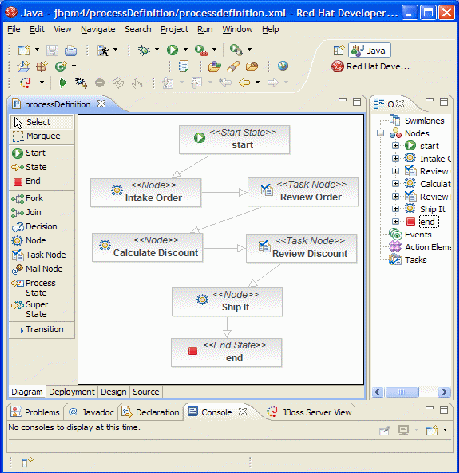
Figure
2. jBPM Grapical Editor
The graphical editor
allows you to create a process definition visually. Nodes and
transitions between nodes can be added, modified or removed. The
process definition saves as an XML document which can be stored on
a file system and deployed to a jBPM instance (database). Each time
you deploy the process instance jBPM will version it and will keep
the older copies. This allows processes that are in flight to
complete using the process instance they were started on. New
process instances will use the latest version of the process
definition.
To
deploy a process definition the server needs to be up and running.
Only then can you go to the 'Deployment' tab in the graphical
designer to deploy a process archive (par). Figure 3 shows the
“Deployment” tab view.
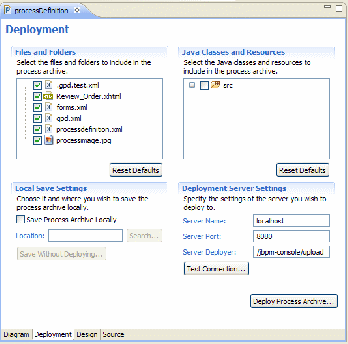
Figure
3. The Deployment View
In
some cases it would suffice to deploy just the
processdefinition.xml, but in most cases you will be deploying
other type of artifacts as well, such as task forms. It is also
possible to deploy Java classes in a par, which means that they end
up in the database where they will be stored and versioned. However
it is strongly discouraged to do this in the ESB environment as you
will risk running into class loading issues. Instead we recommend
deploying your classes in the lib directory of the server. You can
deploy a process definition
straight
from the eclipse plugin, by clicking on the “Test Connection..”
button and, on success, by clicking on the “Deploy Process
Archive” button,
by
saving the deployment to a par file and using the jBPM console to
deploy the archive, see Figure 4, or finally,
by
using the DeployProcessToServer jBPM ant task.

Figure
4. Someone with administrative privileges can deploy new process
definition.
JBossESB
to jBPM
JBossESB
can make calls into jBPM using the BpmProcessor action. This action
uses the jBPM command API to make calls into jBPM. The following
jBPM commands have been implemented:
NewProcessInstanceCommand
- Start a new ProcessInstance given a process definition that was
already deployed to jBPM. The NewProcessInstance-Command leaves the
Process Instance in the start state, which would be needed if there
is an task associated to the Start node (i.e. some task on some
actor's tasklist). In most cases however you would like the new
Process Instance to move to the first node, which is where the next
command comes in.
StartProcessInstanceCommand
- Identical to the NewProcessInstance-Command, but additionally the
new Process Instance is moved from the Start position into the first
Node.
CancelProcessInstanceCommand
- Cancel a ProcessInstance. i.e. when an event comes in which should
result in the cancellation of the entire ProcessInstance. This
action requires some jBPM context variables to be set on the
message, in particular the ProcessInstance Id. Details on that are
discussed later.
The
configuration for this action in the jboss-esb.xml looks like
<action
name="create_new_process_instance"
class="org.jboss.soa.esb.services.jbpm.actions.BpmProcessor">
<property
name="command" value="StartProcessInstanceCommand"
/>
<property
name="process-definition-name"
value="processDefinition2"/>
<property
name="actor" value="FrankSinatra"/>
<property
name="esbToBpmVars">
<!-- esb-name maps to
getBody().get("eVar1") -->
<mapping
esb="eVar1" bpm="counter" default="45"
/>
<mapping
esb="BODY_CONTENT" bpm="theBody" />
</property>
</action>
There
are two required action attributes:
name
- required attribute. You are free to use any value for the name
attribute as long as it is unique in the action pipeline.
class
- required attribute. This attributes needs to be set to
“org.jboss.soa.esb.services.jbpm.actions.BpmProcessor”
Furthermore
one can configure the following configuration properties:
command
– required property. Needs to be one of:
NewProcessInstanceCommand, StartProcessInstanceCommand,
GetProcessInstanceVariablesCommand or CancelProcessInstanceCommand.
processdefinition
– required property for the New- and Start-ProcessInstanceCommands
if the process-definition-id property is not used. The value
of this property should reference a process definition that is
already deployed to jBPM and of which you want to create a new
instance. This property does not apply to the Signal- and
CancelProcessInstance-Commands.
process-definition-id
– required property for the New- and Start-ProcessInstanceCommands
if the processdefinition property is not used. The value of
this property should reference a processdefintion id in jBPM of
which you want to create a new instance. This property does not
apply to the Signal- and CancelProcessInstanceCommands.
actor
– optional property to specify the jBPM actor id, which applies to
the New- and StartProcessInstanceCommands only.
key
– optional property to specify the value of the jBPM key. For
example one can pass a unique invoice id as the value for this key.
On the jBPM side this key is as the “business” key id field. The
key is a string based business key property on the process
instance. The combination of business key + process definition must
be unique if a business key is supplied. The key value can hold an
MVEL expression to extract the desired value from the EsbMessage.
For example if you have a named parameter called “businessKey”
in the body of your message you would use “body.businessKey”.
Note that this property is used for the New- and
StartProcessInstanceCommands only.
transition-name
– optional property. This property only applies to the
StartProcessInstance- and Signal Commands, and is of use only if
there are more then one transition out of the current node.
If this property is not specified the default transition out
of the node is taken. The default transition is the first
transition in the list of transition defined for that node in the
jBPM processdefinition.xml.
esbToBpmVars
- optional property for the New- and StartProcessInstanceCommands.
This property defines a list of variables that need to be extracted
from the EsbMessage and set into jBPM context for the particular
process instance. The list consists of mapping elements. Each
mapping element can have the following attributes:
esb
– required attribute which can contain an MVEL expression to
extract a value anywhere from the EsbMessage.
bpm
– optional attribute containing the name which be used on the jBPM
side. If omitted the esb name is used.
default
– optional attribute which can hold a default value if the esb
MVEL expression does not find a value set in the EsbMessage.
reply-to-originator
- optional property for the New- and StartProcessInstanceCommands.
If this property is specified, with a value of true, then the
creation of the process instance will store the ReplyTo/FaultTo EPRs
of the invoking message within the process instance. These values
can then be used within subsequent EsbNotifier/EsbActionHandler
invocations to deliver a message to the ReplyTo/FaultTo addresses.
Finally
some variables can be set on the body of the EsbMessage:
Exception
Handling JBossESB to jBPM
For
ESB calls into jBPM an exception of the type JbpmException can be
thrown from the jBPM Command API. This exception is not handled by
the integration and we let it propagate into the ESB Action
Pipeline code. The action pipeline will log the error, send the
message to the DeadLetterService (DLS), and send the an error
message to the faultTo EPR, if a faultTo EPR is set on the message.
jBPM
to JBossESB
The
JBossESB to jBPM maybe interesting but the other way around is
probably far more interesting jBPM to JBossESB communication
provides us with the capability to use jBPM for service
orchestration. Service Orchestration itself will be discussed in
more detail in the next chapter and here we're focusing on the
details of the integration first. The integration implements two
jBPM action handler classes. The classes are “EsbActionHandler”
and “EsbNotifier”. The EsbActionHandler is a request-reply
type action, which drops a message on a Service and then waits for
a response while the EsbNotifier only drops a message on a Service
and continues its processing. The interaction with JBossESB is
asynchronous in nature and does not block the process instance
while the Service executes. First we'll discuss the EsbNotifier as
it implements a subset of the configuration of EsbActionHandler
class.
EsbNotifier
The
EsbNotifier action should be attached to an outgoing transition.
This way the jBPM processing can move along while the request to
the ESB service is processed in the background. In the jBPM
processdefinition.xml we would need attach the EsbNotifier to the
outgoing transition. For example the configuration for a “Ship
It” node could look like:
<node name="ShipIt">
<transition
name="ProcessingComplete" to="end">
<action
name="ShipItAction" class=
"org.jboss.soa.esb.services.jbpm.actionhandlers.EsbNotifier">
<esbCategoryName>BPM_Orchestration4</esbCategoryName>
<esbServiceName>ShippingService</esbServiceName>
<bpmToEsbVars>
<mapping
bpm="entireCustomerAsObject" esb="customer" />
<mapping
bpm="entireOrderAsObject" esb="orderHeader" />
<mapping
bpm="entireOrderAsXML" esb="entireOrderAsXML" />
</bpmToEsbVars>
</action>
</transition>
</node>
The
following attributes can be specified:
The
following subelements can be specified:
esbCategoryName
– The category name of the ESB service, required if
not using the reply-to-originator functionality.
esbServiceName –
The name of the ESB service, required if not using the
reply-to-originator functionality.
replyToOriginator
– Specify the 'reply' or 'fault' originator address previously
stored in the process instance on creation.
globalProcessScope
- optional element. This boolean valued parameter sets the default
scope in which the bpmToEsbVars are looked up. If the
globalProcessScope is set to true the variables are looked for up
the token hierarchy (= process-instance scope). If set to false it
retrieves the variables in the scope of the token. If the given
token does not have a variable for the given name, the variable is
searched for up the token hierarchy. If omitted the
globalProcessScope is set to false for retrieving variables.
bpmToEsbVars
– optional element. This element takes a list of mapping
subelements to map a jBPM context variable to a location in the
EsbMessage. Each mapping element can have the following attributes:
bpm
– required attribute. The name of the variable in jBPM context.
The name can be MVEL type expression so you can extract a specific
field from a larger object. The MVEL root is set to the jBPM
“ContextInstance”,
so for example you can use mapping like:
<mapping
bpm="token.name" esb="TokenName" />
<mapping bpm="node.name"
esb="NodeName" />
<mapping bpm="node.id"
esb="esbNodeId" />
<mapping
bpm="node.leavingTransitions[0].name"
esb="transName"
/>
<mapping
bpm="processInstance.id"
esb="piId"
/>
<mapping
bpm="processInstance.version"
esb="piVersion"
/>
and one can reference jBPM context variable names directly.
esb
– optional attribute. The name of the variable on the EsbMessage.
The name can be a MVEL type expression. By default the variable is
set as a named parameter on the body of the EsbMessage. If you
decide to omit the esb attribute, the value of the bpm attribute is
used.
default
– optional attribute. If the variable is not found in jBPM context
the value of this field is taken instead.
process-scope
– optional attribute. This boolean valued parameter can
override the setting of the setting of the globalProcessScope for
this mapping.
When
working on variable mapping configuration it is recommended to turn
on debug level logging.
EsbActionHandler
The
EsbActionHandler is designed to work as a reply-response type call
into JBossESB. The EsbActionHandler should be attached to the node.
When this node is entered this action will be called. The
EsbActionHandler executes and leaves the node waiting for a
transition signal. The signal can come from any other thread of
execution, but under normal processing the signal will be sent by
the JBossESB callback Service. An example configuration for the
EsbActionHandler could look like:
<node name="Intake
Order">
<action
name="esbAction" class=
"org.jboss.soa.esb.services.jbpm.actionhandlers.EsbActionHandler">
<esbCategoryName>BPM_Orchestration4</esbCategoryName>
<esbServiceName>IntakeService</esbServiceName>
<bpmToEsbVars>
<mapping
bpm="entireOrderAsXML" esb="BODY_CONTENT" />
</bpmToEsbVars>
<esbToBpmVars>
<mapping
esb="body.entireOrderAsXML" bpm="entireOrderAsXML"
/>
<mapping
esb="body.orderHeader" bpm="entireOrderAsObject"
/>
<mapping
esb="body.customer" bpm="entireCustomerAsObject"
/>
<mapping
esb="body.order_orderId" bpm="order_orderid" />
</esbToBpmVars>
</action>
<transition
name="" to="Review Order"></transition>
</node>
The
configuration for the EsbActionHandler action extends the
EsbNotifier configuration. The extensions are the following
subelements:
esbToBpmVars
– optional element. This subelement is identical to the
esbToBpmVars property mention in the previous section “JBossESB
to jBPM” for the BpmProcessor configuration. The element
defines a list of variables that need to be extracted from the
EsbMessage and set into jBPM context for the particular process
instance, however, it should be noted that the effect of the
globalProcessScope value, if not specified, will default to true
when setting variables. The list consists of mapping elements. Each
mapping element can have the following attributes:
esb
– required attribute which can contain an MVEL expression to
extract a value anywhere from the EsbMessage.
bpm
– optional attribute containing the name which be used on the jBPM
side. If omitted the esb name is used.
default
– optional attribute which can hold a default value if the esb
MVEL expression does not find a value set in the EsbMessage.
Optionally
you may want to specify a timeout value for this action. For this
you can use a jBPM native Timer on the node. If for example you
only want to wait 10 seconds for the Service to complete you could
add
<timer
name='timeout' duedate='10 seconds' transition='time-out'/>
to
the node element. Now if no signal is received within 10 seconds of
entering this node, the transition called “time-out” is taken.
Exception
Handling jBPM -> JBossESB
There
are two types of scenarios where exceptions can arise.
The
first type of exception is a MessageDeliveryException which is
thrown by the ServiceInvoker. If this occurs it means that delivery
of the message to the ESB failed. If this happens things are pretty
bad and you have probably misspelled the name of the Service you are
trying to reach. This type of exception can be thrown from both the
EsbNotifier as well as the EsbActionHandler. In the jBPM node one
can add an ExceptionHandler [TB-JBPM-USER] to handle this exception.
[TB-JBPM-USER] to handle this exception.
The
second type of exception is when the Service received the request,
but something goes wrong during processing. Only if the call was
made from the EsbActionHandler does it makes sense to report back
the exception to jBPM. If the call was made from the EsbNotifier
jBPM processing has already moved on, and it is of little value to
notify the process instance of the exception. This is why the
exception-transition can only be specified for EsbAction-Handler.
To
illustrate the type of error handling that is now possible using
standard jBPM features we will discuss some scenarios illustrated
in Figure 5.
Scenario
1. Time-out
When
using the EsbActionHandler action and the node is waiting for a
callback, it maybe that you want to limit how long you want to wait
for. For this scenario you can add a timer to the node. This is how
Service1 is setup in Figure 5. The timer can be set to a certain
due date. In this case it is set to 10 seconds. The process
definition configuration would look like
<node
name="Service1">
<action class=
"org.jboss.soa.esb.services.jbpm.actionhandlers.EsbActionHandler">
<esbCategoryName>MockCategory</esbCategoryName>
<esbServiceName>MockService</esbServiceName>
</action>
<timer name='timeout'
duedate='10 seconds'
transition='time-out-transition'/>
<transition name="ok"
to="Service2"></transition>
<transition
name="time-out-transition" to="ExceptionHandling"/>
</node>
Node
“Service1” has 2 outgoing transitions. The first one is called
“ok” while the second one is called “time-out-transition”.
Under normal processing the call back would signal the default
transition, which is the “ok” transition since it is defined
first. However if the execution of the service takes more then 10
seconds the timer will fire. The transition attribute of the timer
is set to “time-out-transition”,so this transition will be
taken on time-out. In Figure 5 this means that the processing ends
up in the “ExceptionHandling” node in which one can perform
compensating work.
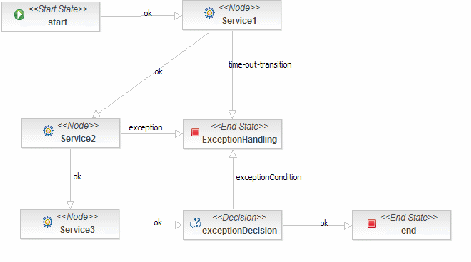
Figure
5. Three exception handling scenarios: time-out,
exception-transition and exception-decision.
Scenario
2. Exception Transition
To
handle exception that may occur during processing of the Service,
one can define an exceptionTransition. When doing so the faultTo
EPR is set on the message such that the ESB will make a callback to
this node, signaling it with the exceptionTransition. Service2 has
two outgoing transitions. Transition “ok” will be taken under
normal processing, while the “exception” transition will be
taken when the Service processing throws an exception. The
definition of Service2 looks like
<node
name="Service2">
<action class=
"org.jboss.soa.esb.services.jbpm.actionhandlers.EsbActionHandler">
<esbCategoryName>MockCategory</esbCategoryName>
<esbServiceName>MockService</esbServiceName>
<exceptionTransition>exception</exceptionTransition>
</action>
<transition name="ok"
to="Service3"></transition>
<transition
name="exception" to="ExceptionHandling"/>
</node>
where
in the action, the exceptionTransition is set to “exception”.
In this scenario the process also ends in the “ExceptionHandling”
node.
Scenario
3. Exception Decision
Scenario
3 is illustrated in the configuration of Service3 and the
“exceptionDecision” node that follows it. The idea is that
processing of Service3 completes normally and the default
transition out of node Service3 is taken. However, somewhere during
the Service execution an errorCode was set, and the
“exceptionDecision” node checks if a variable called
“errorCode” was set. The configuration would look like
<node
name="Service3">
<action class=
"org.jboss.soa.esb.services.jbpm.actionhandlers.EsbActionHandler">
<esbCategoryName>MockCategory</esbCategoryName>
<esbServiceName>MockService</esbServiceName>
<esbToBpmVars>
<mapping
esb="SomeExceptionCode" bpm="errorCode"/>
</esbToBpmVars>
</action>
<transition name="ok"
to="exceptionDecision"></transition>
</node>
<decision
name="exceptionDecision">
<transition name="ok"
to="end"></transition>
<transition
name="exceptionCondition" to="ExceptionHandling">
<condition>#{
errorCode!=void }</condition>
</transition>
</decision>
where
the esbToBpmVars mapping element extracts the errorCode called
“Some-ExceptionCode” from the EsbMessage body and sets in the
jBPM context, if this “SomeExceptionCode” is set that is. In
the next node “exceptionDecision” the “ok” transition is
taken under normal processing, but if a variable called “errorCode”
is found in the jBPM context, the “exceptionCondition”
transition is taken. This is using the decision node feature of
jBPM where transition can nest a condition.
Here we check for the existence of the “errorCode” variable
using the condition
<condition>#{
errorCode!=void }</condition>
For
more details on conditional transitions please see the jBPM
documentation [TB-JBPM-USER].
�
Chapter 11
Service
Orchestration
Introduction
Service
Orchestration is the arrangement of business processes.
Traditionally BPEL is used to execute SOAP based WebServices. If
you want to orchestrate JBossESB regardless of their end point
type, then it makes more sense to use jBPM. This chapter explains
how to use the integration discussed earlier to do Service
Orchestration using jBPM.
Orchestrating Web
Services
JBossESB
provides WS-BPEL support via its Web Service components. For
details on these components and how to configure and use them, see
the Message Action Guide.
JBoss
and JBossESB also have a special support agreement with
ActiveEndpoints for
their award wining ActiveBPEL
WS-BPEL Engine. In support of this, JBossESB ships with a
Quickstart dedicated to demonstrating how JBossESB and ActiveBPEL
can collaborate effectively to provide a WS-BPEL based
orchestration layer on top of a set of Services that don't expose
Webservice Interfaces (the “webservice_bpel” Quickstart).
JBossESB provides the Webservice Integration and ActiveBPEL
provides the Process Orchestration. A number of flash based
walk-thrus of this Quickstart are also available
online.
ActiveEndpoints
WS-BPEL engine does not run on versions of JBossAS since 4.0.5.
However, it can be deployed and run successfully on Tomcat as our
examples illustrate.
Orchestration
Diagram
A
key component of Service Orchestration is to use a flow-chart like
design tool to design and deploy processes. The jBPM IDE can be
used for just this. Figure 6 shows an example of such a flow-chart,
which represents a simplified order process. This example is taken
from the bpm_orchestration4 quick start [JBESB-QS] which ships with
JBossESB.
�
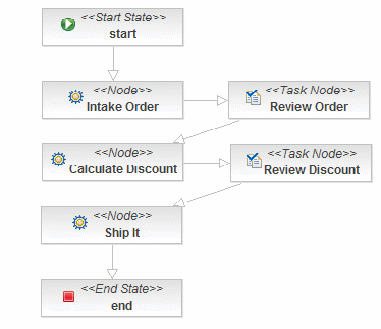
Figure
6. “Order Process” Service Orchestration using jBPM
In
the “Order Process” Diagram three of the nodes are JBossESB
Services, the “Intake Order”, “Calculate Discount” and the
“Ship It” nodes. For these nodes the regular “Node” type
was used, which is why these are labeled with “<<Node>>”.
Each of these nodes have the EsbActionHandler attached to the node
itself. This means that the jBPM node will send a request to the
Service and then it will remain in a wait state, waiting for the
ESB to call back into the node with the response of the Service.
The response of the service can then be used within jBPM context.
For example when the Service of the “Intake Order” responds,
the response is then used to populate the “Review Order” form.
The “Review Order” node is a “Task Node”. Task Nodes are
designed for human interaction. In this case someone is required to
review the order before the Order Process can process.
To
create the diagram in Figure 6, select File > New > Other,
and from the Selection wizard select “JBoss jBPM “Process
Definition” as shown in Figure 7. The wizard will direct you to
save the process definition. From an organizational point of view
it is recommended use one directory per process definition, as you
will typically end up with multiple files per process design.
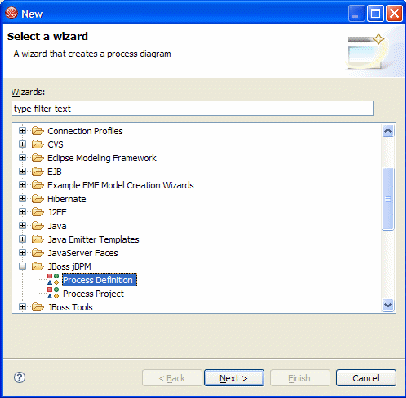
Figure
7. Select new JBoss jBPM Process Definition
After
creating a new process definition. You can drag and drop any item
from menu, shown in Figure 8, into the process design view. You can
switch between the design and source modes if needed to check the
XML elements that are being added, or to add XML fragments that are
needed for the integration. Recently a new type of node was added
called “ESB Service" [KA-BLOG].
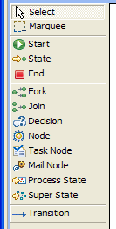
Figure
8. jBPM IDE menu palette.
Before
building the “Order Process” diagram of Figure 6, we'd need to
create and test the three Services. These services are 'ordinary'
ESB services and are defined in the jboss-esb.xml. Check the
jboss-esb.xml of the bpm_orchestration4 quick start [JBESB-QS] if
you want details on them, but they only thing of importance to the
Service Orchestration are the Services names and categories as
shown in the following jboss-esb.xml fragment:
<services>
<service
category="BPM_orchestration4_Starter_Service"
name="Starter_Service"
description="BPM
Orchestration Sample 4: Use this service to start a process
instance">
....
</service>
<service
category="BPM_Orchestration4" name="IntakeService"
description="IntakeService:
transforms, massages, calculates priority">
....
</service>
<service
category="BPM_Orchestration4" name="DiscountService"
description="DiscountService">
</service>
<service
category="BPM_Orchestration4" name="ShippingService"
description="ShippingService">
....
</service>
</services>
These
Service can be referenced using the EsbActionHandler or EsbNotifier
Action Handlers as discussed in Chapter 1. The EsbActionHandler is
used when jBPM expects a response, while the EsbNotifier can be
used if no response back to jBPM is needed.
Now
that the ESB services are known we drag the “Start” state node
into the design view. A new process instance will start a process
at this node. Next we drag in a “Node” (or “ESB Service “if
available). Name this Node “Intake Order”. We can connect the
Start and the Intake Order Node by selecting “Transition” from
the menu and by subsequently clicking on the Start and Intake Order
Node. You should now see an arrow connecting these two nodes,
pointing to the Intake Order Node.
Next
we need to add the Service and Category names to the Intake Node.
Select the “Source” view. The “Intake Order Node should look
like
<node name="Intake
Order">
<transition
name="" to="Review Order"></transition>
</node>
and
we add the EsbHandlerAction class reference and the subelement
configuration for the Service Category and Name, BPM_Orchestration4
and“IntakeService” respectively
<node name="Intake
Order">
<action
name="esbAction" class="
org.jboss.soa.esb.services.jbpm.actionhandlers.EsbActionHandler">
<esbCategoryName>BPM_Orchestration4</esbCategoryName>
<esbServiceName>IntakeService</esbServiceName>
<!-- async call
of IntakeService -->
</action>
<transition
name="" to="Review Order"></transition>
</node>
Next
we want to send the some jBPM context variables along with the
Service call. In this example we have a variable named
“entireOrderAsXML” which we want to set in the default position
on the EsbMessage body. For this to happen we add
<bpmToEsbVars>
<mapping
bpm="entireOrderAsXML" esb="BODY_CONTENT" />
</bpmToEsbVars>
which
will cause the XML content of the variable “entireOrderAsXML”
to end up in the body of the EsbMessage, so the IntakeService will
have access to it, and the Service can work on it, by letting it
flow through each action in the Action Pipeline. When the last
action is reached it the replyTo is checked and the EsbMessage is
send to the JBpmCallBack Service, which will make a call back into
jBPM signaling the “Intake Order” node to transition to the
next node (“Review Order”). This time we will want to send some
variables from the EsbMessage to jBPM. Note that you can send
entire objects as long both contexts can load the object's class.
For the mapping back to jBPM we add an “esbToEsbVars” element.
Putting it all together we end up with:
<node name="Intake
Order">
<action
name="esbAction" class=
"org.jboss.soa.esb.services.jbpm.actionhandlers.EsbActionHandler">
<esbCategoryName>BPM_Orchestration4</esbCategoryName>
<esbServiceName>IntakeService</esbServiceName>
<bpmToEsbVars>
<mapping
bpm="entireOrderAsXML" esb="BODY_CONTENT" />
</bpmToEsbVars>
<esbToBpmVars>
<mapping
esb="body.entireOrderAsXML" bpm="entireOrderAsXML"/>
<mapping
esb="body.orderHeader" bpm="entireOrderAsObject"
/>
<mapping
esb="body.customer" bpm="entireCustomerAsObject"
/> <mapping esb="body.order_orderId"
bpm="order_orderid" />
<mapping
esb="body.order_totalAmount" bpm="order_totalamount"
/> <mapping esb="body.order_orderPriority"
bpm="order_priority" />
<mapping
esb="body.customer_firstName" bpm="customer_firstName"
/>
<mapping
esb="body.customer_lastName" bpm="customer_lastName"
/>
<mapping
esb="body.customer_status" bpm="customer_status"
/>
</esbToBpmVars>
</action>
<transition name=""
to="Review Order"></transition>
</node>
So
after this Service returns we have the following variables in the
jBPM context for this process: entireOrderAsXML,
entireOrderAsObject, entireCustomerAsObject, and for demo purposes
we also added some flattened variables: order_orderid,
order_totalAmount, order_priority, customer_firstName,
customer_lastName and customer_status.
�
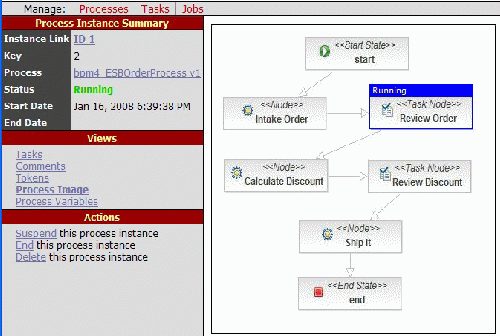
Figure
9. The Order process reached the “Review Order” node
In
our Order process we require a human to review the order. We
therefore add a “Task Node” and add the task “Order Review”,
which needs to be performed by someone with actor_id “user”.
The XML-fragment looks like
<task-node
name="Review Order">
<task name="Order
Review">
<assignment
actor-id="user"></assignment>
<controller>
<variable
name="customer_firstName"
access="read,write,required"></variable>
<variable
name="customer_lastName"
access="read,write,required">
<variable
name="customer_status" access="read"></variable>
<variable
name="order_totalamount" access="read"></variable>
<variable
name="order_priority" access="read"></variable>
<variable
name="order_orderid" access="read"></variable>
<variable
name="order_discount" access="read"></variable>
<variable
name="entireOrderAsXML" access="read"></variable>
</controller>
</task>
<transition
name="" to="Calculate Discount"></transition>
</task-node>
In
order to display these variables in a form in the jbpm-console we
need to create an xhtml dataform (see the Review_Order.xhtml file
in the bpm_orchestration4 quick start [JBESB-QS] and tie this for
this TaskNode using the forms.xml file:
<forms>
<form task="Order
Review" form="Review_Order.xhtml"/>
<form task="Discount
Review" form="Review_Order.xhtml"/>
</forms>
Note
that in this case the same form is used in two task nodes. The
variables are referenced in the Review Order form like
<jbpm:datacell>
<f:facet name="header">
<h:outputText
value="customer_firstName"/>
</f:facet>
<h:inputText
value="#{var['customer_firstName']}" />
</jbpm:datacell>
which
references the variables set in the jBPM context.
When
the process reaches the “Review Node”, as shown in Figure 9.
When the 'user' user logs into the jbpm-console the user can click
on 'Tasks” to see a list of tasks, as shown in Figure 10. The
user can 'examine' the task by clicking on it and the user will be
presented with a form as shown in Figure 11. The user can update
some of the values and click “Save and Close” to let the
process move to the next Node.

Figure
10. The task list for user 'user'
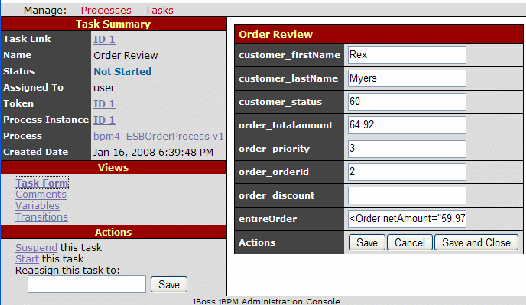
Figure
11. The “Order Review” form.
The
next node is the “Calculate Discount” node. This is an ESB
Service node again and the configuration looks like
<node
name="Calculate Discount">
<action
name="esbAction" class="
org.jboss.soa.esb.services.jbpm.actionhandlers.EsbActionHandler">
<esbCategoryName>BPM_Orchestration4</esbCategoryName>
<esbServiceName>DiscountService</esbServiceName>
<bpmToEsbVars>
<mapping
bpm="entireCustomerAsObject" esb="customer" />
<mapping
bpm="entireOrderAsObject" esb="orderHeader" />
<mapping
bpm="entireOrderAsXML" esb="BODY_CONTENT" />
</bpmToEsbVars>
<esbToBpmVars>
<mapping
esb="order"
bpm="entireOrderAsObject"
/>
<mapping
esb="body.order_orderDiscount"
bpm="order_discount" />
</esbToBpmVars>
</action>
<transition name=""
to="Review Discount"></transition>
</node>
The
Service receives the customer and orderHeader objects as well as
the entireOrderAsXML, and computes a discount. The response maps
the body.order_orderDiscount value onto a jBPM context variable
called “order_-discount”, and the process is signaled to move
to the “Review Discount” task node.
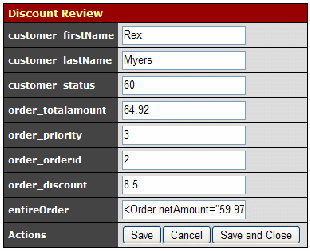
Figure 12. The
Discount Review form
The user is asked to
review the discount, which is set to 8.5. On “Save and Close”
the process moves to the “Ship It” node, which again is an ESB
Service. If you don't want the Order process to wait for the Ship
It Service to be finished you can use the EsbNotifier action
handler and attach it to the outgoing transition:
<node name="ShipIt">
<transition
name="ProcessingComplete" to="end">
<action
name="ShipItAction" class=
"org.jboss.soa.esb.services.jbpm.actionhandlers.EsbNotifier">
<esbCategoryName>BPM_Orchestration4</esbCategoryName>
<esbServiceName>ShippingService</esbServiceName>
<bpmToEsbVars>
<mapping
bpm="entireCustomerAsObject" esb="customer" />
<mapping
bpm="entireOrderAsObject" esb="orderHeader" />
<mapping
bpm="entireOrderAsXML" esb="entireOrderAsXML" />
</bpmToEsbVars>
</action>
</transition>
</node>
After
notifying the ShippingService the Order process moves to the 'end'
state and terminates. The ShippingService itself may still be
finishing up. In bpm_orchestration4 [JBESB-QS] it uses drools to
determine whether this order should be shipped 'normal' or
'express'.
Process
Deployment and Instantiation
In
the previous paragraph we create the process definition and we
quietly assumed we had an instance of it to explain the process
flow. But now that we have created the processdefinition.xml, we
can deploy it to jBPM using the IDE, ant or the jbpm-console (as
explained in Chapter 1). In this example we use the IDE and
deployed the files: Review_Order.xhtml, forms.xml, gpd.xml,
processdefinition.xml and the processimage.jpg. On deployment the
IDE creates a par achive and deploys this to the jBPM database. We
do not recommend deploying Java code in par archives as it may
cause class loading issues. Instead we recommend deploying classes
in jar or esb archives.
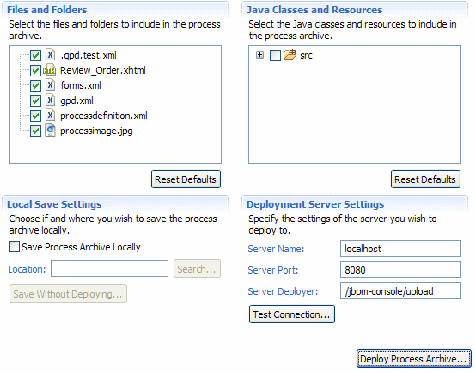
Figure
13. Deployment of the “Order Process”
When
the process definition is deployed a new process instance can be
created. It is interesting to note that we can use the
'StartProcessInstanceCommand” which allows us to create a process
instance with some initial values already set. Take a look at
<service
category="BPM_orchestration4_Starter_Service"
name="Starter_Service"
description="BPM
Orchestration Sample 4: Use this service to start a
process instance">
<listeners>
....
</listeners>
<actions>
<action
name="setup_key" class=
"org.jboss.soa.esb.actions.scripting.GroovyActionProcessor">
<property
name="script"
value="/scripts/setup_key.groovy"
/>
</action>
<action
name="start_a_new_order_process" class=
"org.jboss.soa.esb.services.jbpm.actions.BpmProcessor">
<property
name="command"
value="StartProcessInstanceCommand"
/>
<property
name="process-definition-name"
value="bpm4_ESBOrderProcess"
/>
<property name="key"
value="body.businessKey" />
<property
name="esbToBpmVars">
<mapping
esb="BODY_CONTENT" bpm="entireOrderAsXML" />
</property>
</action>
</actions>
</service>
where
new process instance is invoked and using some groovy script, and
the jBPM key is set to the value of 'OrderId' from an incoming
order XML, and the same XML is subsequently put in jBPM context
using the esbToBpmVars mapping. In the bpm_orchestration4
quickstart [JBESB-QS] the XML came from the Seam DVD Store and the
“SampleOrder.xml” looks like
<Order orderId="2"
orderDate="Wed Nov 15 13:45:28 EST 2006" statusCode="0"
netAmount="59.97" totalAmount="64.92"
tax="4.95">
<Customer userName="user1"
firstName="Rex" lastName="Myers" state="SD"/>
<OrderLines>
<OrderLine position="1"
quantity="1">
<Product productId="364"
title="Superman Returns"
price="29.98"/>
</OrderLine>
<OrderLine position="2"
quantity="1">
<Product productId="299"
title="Pulp Fiction" price="29.99"/>
</OrderLine>
</OrderLines>
</Order>
Note
that both ESB as well as jBPM deployments are hot. An extra feature
of jBPM is that process deployments are versioned. Newly created
process instances will use the latest version while existing
process instances will finish using the process deployment on which
they where started.
Conclusion
We
have demonstrated how jBPM can be used to orchestrate Services as
well as do Human Task Management. Note that you are free to use any
jBPM feature. For instance look at the quick start
bpm_orchestration2 [JBESB-QS] how to use the jBPM fork and join
concepts.
�
Chapter 12
The Message Store
Introduction
The
message store mechanism in JBossESB is designed with audit tracking
purposes in mind. As with other ESB services, it is a pluggable
service, which allows for you, the developer to plug in your own
persistence mechanism should you have special needs. The
implementation supplied with JBossESB is a database persistence
mechanism. If you require say, a file persistence mechanism, then
it’s just a matter of you writing your own service to do this,
and override the default behaviour with a configuration change.
One
thing to point out with the Message Store – this is a base
implementation. We will be working with the community and partners
to drive the feature functionality set of the message store to
support advanced audit and management requirements. This is meant
to be a starting point.
In
JBossESB 4.2 the Message Store is also used for storing messages
that need to be redelivered in the event of failures. See the
Programmers Guide around the ServiceInvoker for further details.
Message Store
interface
The
org.jboss.soa.esb.services.persistence.MessageStore
interface is defined as follows:
public
interface
MessageStore
{
public
MessageURIGenerator getMessageURIGenerator();
public
URI addMessage (Message message, String classification) throws
MessageStoreException;
public
Message getMessage (URI uid) throws
MessageStoreException;
public
void
setUndelivered(URI uid) throws
MessageStoreException;
public
void
setDelivered(URI uid) throws
MessageStoreException;
public
Map<URI, Message> getUndeliveredMessages(String
classification) throws
MessageStoreException;
public
Map<URI, Message> getAllMessages(String classification) throws
MessageStoreException;
public
Message getMessage (URI uid, String classification) throws
MessageStoreException;
public
int
removeMessage (URI uid, String classification) throws
MessageStoreException;
}
The MessageStore
is responsible for reading and writing Messages
upon request. Each Message
must be uniquely identified within the context of the store and
each MessageStore
implementation uses a URI
to accomplish this identification. This URI is used as the “key”
for that message in the database.
MessageStore
implementations may use different formats for their URIs.
Messages
can be stored within the store based upon classification
using addMessage.
If the classification
is not defined then it is up to the implementation of the
MessageStore
how it will store the Message.
Furthermore, the classification
is only a hint: implementations are free to ignore this field if
necessary.
It is
implementation dependent as to whether or not the MessageStore
imposes any kind of concurrency control on individual Messages.
As such, you should use the removeMessage
operation with care.
Because
the current MessageStore
interface is designed to support both audit trail and redelivery
scenarios, you should not use the setUndelivered/setDelivered
and associated operations unless they are applicable!
The
default implementation of the MessageStore is provided by the
org.jboss.internal.soa.esb.persistence.format.db.DBMessageStoreImpl
class. The methods in this implementation make the required
DB connections (using a pooled Database Manager
DBConnectionManager).
To
override the MessageStore
implementation you should look at the MessageActionGuide and
the MessagePersister
Action.
Transactions
The
Message Store interface does not currently support transactions. As
such, any use of the store within the scope of a global transaction
will not be coordinated within the scope of any global transaction,
i.e., each message store update or read will be done as a separate,
independent, transaction. Future versions of the Message Store will
provide for control over whether or not specific interactions
should be conducted within the scope of any enclosing transactional
context.
Configuring the
Message Store
To
configure your Message Store, you can change and override the
default service implementation through the following settings found
in the jbossesb-properties.xml:
<properties
name="dbstore">
<!--
connection manager type -->
<property
name="org.jboss.soa.esb.persistence.db.conn.manager"
value="org.jboss.internal.soa.esb.persistence.manager.StandaloneConnectionManager"/>
<!-- property
name="org.jboss.soa.esb.persistence.db.conn.manager"
value="org.jboss.internal.soa.esb.persistence.manager.J2eeConnectionManager"/
-->
<!-- this property is only used
if using the j2ee connection manager -->
<property
name="org.jboss.soa.esb.persistence.db.datasource.name"
value="java:/JBossesbDS"/>
<!--
standalone connection pooling settings -->
<!--
mysql
<property
name="org.jboss.soa.esb.persistence.db.connection.url"
value="jdbc:mysql://localhost/jbossesb"/>
<property
name="org.jboss.soa.esb.persistence.db.jdbc.driver"
value="com.mysql.jdbc.Driver"/>
<property
name="org.jboss.soa.esb.persistence.db.user"
value="kstam"/>
-->
<!--
postgres
<property
name="org.jboss.soa.esb.persistence.db.connection.url"
value="jdbc:postgresql://localhost/jbossesb"/>
<property
name="org.jboss.soa.esb.persistence.db.jdbc.driver"
value="org.postgresql.Driver"/>
<property
name="org.jboss.soa.esb.persistence.db.user"
value="postgres"/>
<property
name="org.jboss.soa.esb.persistence.db.pwd"
value="postgres"/>
-->
<!--
hsqldb -->
<property
name="org.jboss.soa.esb.persistence.db.connection.url"
value="jdbc:hsqldb:hsql://localhost:9001/jbossesb"/>
<property
name="org.jboss.soa.esb.persistence.db.jdbc.driver"
value="org.hsqldb.jdbcDriver"/>
<property
name="org.jboss.soa.esb.persistence.db.user"
value="sa"/>
<property
name="org.jboss.soa.esb.persistence.db.pwd"
value=""/>
<property
name="org.jboss.soa.esb.persistence.db.pool.initial.size" value="2"/>
<property
name="org.jboss.soa.esb.persistence.db.pool.min.size" value="2"/>
<property
name="org.jboss.soa.esb.persistence.db.pool.max.size" value="5"/>
<!--table
managed by pool to test for valid connections - created by pool
automatically -->
<property
name="org.jboss.soa.esb.persistence.db.pool.test.table" value="pooltest"/>
<property
name="org.jboss.soa.esb.persistence.db.pool.timeout.millis" value="5000"/>
</properties>
The
section in the property file called “dbstore” has all the
settings required by the database implementation of the message
store. The standard settings, like URL, db user, password, pool
sizes can all be modified here.
The
scripts for the required database schema, are again, very simple.
They can be found under
lib/jbossesb.esb/message-store-sql/<db_type>/create_database.sql
of your JBossESB installation.
The
structure of the table can be seen from the sample SQL:
CREATE
TABLE message
(
uuid varchar(128) NOT
NULL,
type varchar(128) NOT
NULL,
message text(4000)
NOT NULL,
delivered varchar(10)
NOT NULL,
classification
varchar(10),
PRIMARY KEY (`uuid`)
);
the uuid column is used
to store a unique key for this message, in the format of a standard
URI. A key for a message would look like:
urn:jboss:esb:message:UID:
+ UUID.randomUUID()
This
logic uses the new UUID random number generator in jdk 1.5.
the
type will be the type of the stored message. JBossESB ships with
JBOSS_XML and JAVA_SERIALIZED currently.
The
“message” column will contain the actual message content.
The
supplied database message store implementation works by invoking a
connection manager to your configured database. Supplied with
JBoss ESB is a standalone connection manager, and another for using
a JNDI datasource.
To
configure the database connection manager, you need to provide the
connection manager implementation in the jbossesb-properties.xml.
The properties that you would need to change are:
<!--
connection manager type -->
<property
name="org.jboss.soa.esb.persistence.db.conn.manager"
value="org.jboss.internal.soa.esb.persistence.format.db.StandaloneConnectionManager"/>
<!--
property name="org.jboss.soa.esb.persistence.db.conn.manager"
value="org.jboss.soa.esb.persistence.manager.J2eeConnectionManager"/
-->
<!-- this property is only used if using the j2ee
connection manager -->
<property
name="org.jboss.soa.esb.persistence.db.datasource.name"
value="java:/JBossesbDS"/>
The
two supplied connection managers for managing the database pool are
org.jboss.soa.esb.persistence.manager.J2eeConnectionManager
org.jboss.soa.esb.persistence.manager.StandaloneConnectionManager
The
Standalone manager uses C3PO to manage the connection pooling
logic, and the J2eeConnectionManager uses a datasource to manage
it's connection pool. This is intended for use when deploying your
ESB endpoints inside a container such as JBoss AS or Tomcat, etc.
You can plug in your own connection pool manager by implementing
the interface:
org.jboss.internal.soa.esb.persistence.manager.ConnectionManager
Once
you have implemented this interface, you update the properties file
with your new class, and the connection manager factory will now
use your implementation.
�
Chapter 13
Security
Introduction
Services
in JBossESB can be configured to be secure which means that the
service will only be executed if authentication succeeds and if the
caller is authorized to execute the service.
A
service can be invoked by using a gateway or by using the
ServiceInvoker to directly invoke the ESB service. When calling a
service via a gateway, the gateway is responsible for extracting
the security information needed to authenticate the caller. It does
this by extracting the information from the transport that the
gateway handles. Using this information the gateway creates an
authentication request that is encrypted and then passed to the
ESB.
When
using the ServiceInvoker a gateway is not involved and it is the
responsibility of the client to create the authentication request
prior to invoking the service. Both of these situations will be
looked at in the following sections.
The
default security implementation is JAAS based but this is a
configurable feature. The following sections describe the security
components and how they can be configured.
Security
Service Configuration
The
Security Service is configured along with everything else in
jbossesb-properties.xml:
<properties
name="security">
<property
name="org.jboss.soa.esb.services.security.implementationClass"
value="org.jboss.internal.soa.esb.services.security.JaasSecurityService"/>
<property
name="org.jboss.soa.esb.services.security.callbackHandler"
value="org.jboss.internal.soa.esb.services.security.UserPassCallbackHandler"/>
<property
name="org.jboss.soa.esb.services.security.sealAlgorithm"
value="TripleDES"/>
<property
name="org.jboss.soa.esb.services.security.sealKeySize"
value="168"/>
<property
name="org.jboss.soa.esb.services.security.contextTimeout"
value="30000"/>
<property
name="org.jboss.soa.esb.services.security.contextPropagatorImplemtationClass"
value="org.jboss.internal.soa.esb.services.security.JBossASContextPropagator"/>
<property
name="org.jboss.soa.esb.services.security.publicKeystore"
value="/publicKeyStore"/>
<property
name="org.jboss.soa.esb.services.security.publicKeystorePassword"
value="testKeystorePassword"/>
<property
name="org.jboss.soa.esb.services.security.publicKeyAlias"
value="testAlias"/>
<property
name="org.jboss.soa.esb.services.security.publicKeyPassword"
value="testPassword"/>
<property
name="org.jboss.soa.esb.services.security.publicKeyTransformation"
value="RSA/ECB/PKCS1Padding"/>
</properties>
|
Property
|
Description
|
|
org.jboss.soa.esb.services.security.implementationClass |
This is the concrete
SecurityService implementation that should be used. Required.
Default is JaasSecurityService. |
|
org.jboss.soa.esb.services.security.callbackHandler |
Optional. A default
CallbackHandler implementation when a JAAS based SecurityService
is being used. See “Customizing security” for
more information about the callbackHandler property. |
|
org.jboss.soa.esb.services.security.sealAlgorithm |
The algorithm to use
for sealing the SecurityContext.
|
|
org.jboss.soa.esb.services.security.sealKeySize |
The size of the
secret/symmetric key used to encrypt/decrypt the SecurityContext. |
|
org.jboss.soa.esb.services.security.contextTimeout |
The amount of time
in milliseconds that a security context is valid for. This is a
global setting that may be overridden on a per service basis by
specifying this same property name on the security element in
jboss-esb.xml. |
|
org.jboss.soa.esb.services.security.contextPropagatorImplementationClass |
Optional property
that configures a global SecurityContextPropagator. For more
details on the SecurityContextPropagator please refer to the
“Security Context Propagation”. |
|
org.jboss.soa.esb.services.security.publicKeystore |
Path to the keystore
that holds a keys used for encrypting and decrypting data external
to the ESB. This is used to encrypt the AuthenticationRequest . |
|
org.jboss.soa.esb.services.security.publicKeystorePassword |
Password to the
public keystore. |
|
org.jboss.soa.esb.services.security.publicKeyAlias |
Alias to use. |
|
org.jboss.soa.esb.services.security.publicKeyPassword |
Password for the
alias if one was specified upon creation. |
|
org.jboss.soa.esb.services.security.publicKeyPassword |
Optional cipher
transformation in the format: “algorithm/mode/padding”. If not
specified this will default to the keys algorithm. |
The
JAAS login modules are configured in the way you would except using
the login-config.xml file located in the conf directory of your
JBoss Application Server. So you can use the ones that come
pre-configured but also add your own login modules.
By
default JBossESB ships with an example keystore which should not be
used in production. It is only provided as a sample to help users
get security working “out of the box”. The sample keystore can
be updated with custom generate key pairs.
Configuring
Security on Services
Security
is configured per-service. A service in JBossESB can be declared as
being secured and that it requires authentication. Services are
configured by adding a “security” element to the service in
jbossesb.xml:
<service
category="Security" name="SimpleListenerSecured">
<security
moduleName="messaging" runAs="adminRole"
rolesAllowed=”adminRole, normalUsers”
callbackHandler="org.jboss.internal.soa.esb.services.security.UserPassCallbackHandler">
<property
name="property1" value="value1"/>
<property
name="property2" value="value2"/>
</security>
...
</service>
Security
properties description:
|
Property |
Description |
|
moduleName |
A named module that
exist in conf/login-config.xml |
|
runAs |
An optional runAs
role. |
|
rolesAllowed |
An optional comma
separated list of roles that are allowed to execute the service.
This is a check that is performed after a caller has been
authenticated, to verfiy that the caller in a member of the roles
specified. The roles will have been assigned after a successful
authentication by the underlying security mechanism. |
|
callbackHandler |
An optional
CallbackHandler that will override the one defined in
jbossesb-properties.xml. |
|
property |
Optional properties
can be defined which will be made available to the CallbackHandler
implementation.
|
Security
properties overrides:
|
Property |
Description |
|
org.jboss.soa.esb.services.security.contextTimeout |
Optional property
that lets the service override the global security context timeout
(ms) specified in jbossesb-properties.xml. |
|
org.jboss.soa.esb.services.security.contextPropagatorImplementationClass |
Optional property
that lets the service override the global security context
propagator class implementation specified in
jbossesb-properties.xml. |
Example of
overriding global configuration settings:
<security
moduleName="messaging" runAs="adminRole"
rolesAllowed=”adminRole”>
<property
name="org.jboss.soa.esb.services.security.contextTimeout"
value="50000"/>
<property
name="org.jboss.soa.esb.services.security.contextPropagatorImplementationClass"
value="org.xyz.CustomSecurityContextPropagator"/>
</security>
Authentication
To
authenticate a caller, security information needs to be provided.
If the call to the service is coming through a gateway, then the
gateway will extract the required information from the transport
that the gateway works with. For a web service call this would
entail extracting either the UsernameToken or the
BinarySecurityToken from the security element in the SOAP header.
When a
service needs to call another services and that service requires
authentication, another authentication process will be performed.
So having a chain of services that are all configured for
authentication will cause multiple authentications to be performed.
To minimize such overhead the ESB will store an encrypted
SecurityContext which will be propagated with the ESB Message
object between services. If the ESB detects that a Message has a
SecurityContext, it checks that the SecurityContext is still valid,
and if so, re-authentication is not performed. Note that the
SecurityContext is only valid on a single ESB node. If the message
is routed to a different ESB node, re-authentication will be
required.
- AuthenticationRequest
An AuthenticationRequest
is intended to carry security information needed for authentication
between a gateway and a service, or between two services.
An
instance of this class should be set on the message object before
calling the service configured for authentication:
byte[]
encrypted = PublicCryptoUtil.INSTANCE.encrypt((Serializable)
authRequest);
message.getContext.setContext(SecurityService.AUTH_REQUEST,
encrypted);
Note that the
authentication context is encrypted and then set in the message
context. This will be decrypted by the ESB to perform
authentication. See the “SecurityService Configuration” section
for information on how to configure the public keystore for this
purpose.
The
“security_basic” quickstart shows an example of using a
external client and how to prepare the Message before using the
ServiceInvoker, see the SendEsbMessage class for more information.
This quickstart also shows how you can configure
jbossesb-properties.xml for client usage.
JBossESB
SecurityContext
A
SecurityContext in JBossESB is an object that is local to a
specific ESB node, or really to the JVM of the node. The
SecurityContext is created after a successful authentication has be
performed and it will be used locally in the ESB where it was
created to save having to re-authenticate with every call.
A
timeout is specified for the context which is the time, in
milliseconds, that the context is valid for. This value can be
specified globally in jbossesb-properties.xml of overridden
per-service by specifying the value in jboss-esb.xml. Please see
“Configuring Secuirtyon a Service” and “SecurityService
Configuration” to see how this is done.
Security Context
Propagation
Propagation,
in this case, refers to propagating security context information in
a way specific to an external system. For example, you might want
to have the credentials that were used to call the ESB, be used as
the credentials when calling an EJB method. This can be
accomplished by specifying a SecurityContextPropagator that will
perform the security context propagation specific to the
destination environment.
A
SecurityContextPropagator can be configured globally by specifying
the
'org.jboss.soa.esb.services.security.contextPropagatorImplementationClass'
in jbossesb-properties.xml, or per-service by specifying the same
property in jboss-esb.xml. Please see “Configuring Security on a
Service” and “SecurityService Configuration” for examples of
this.
Implementations of
SecurityContextPropagator
|
Class |
Description |
|
Package:
org.jboss.internal.soa.esb.services.security
Class:
JBossASContextPropagator |
This
propagator will propagate security credentials to a JBoss
Application Server(AS). If you need to write your own
implementation you only have to write a class that implements
org.jboss.internal.soa.esb.services.security.SecurityContextPropagator
and then either specify that implementation in
jbossesb-properties.xml or jboss-esb.xml as noted above. |
Customizing
security
The
default security implementation in JBossESB is based on JAAS and
named JaasSecurityService. Custom login modules can
be added in conf/login-config.xml of an JBoss Application Server.
Since
different login modules will require different information, the
callback handler to be used can be specified in the security
configuration for that Service. This can be accomplished by
specifying the 'callbackHandler' attribute belonging to the
security element defined on the service.
The
callbackHandler should specify a fully qualified class name of a
class that implements the EsbCallbackHandler interface:
public
interface
EsbCallbackHandler extends
CallbackHandler
{
void
setAuthenticationRequest(final
AuthenticationRequest authRequest);
void
setSecurityConfig(final
SecurityConfig config);
}
The AuthenticationRequest
will contain the principal and credentials needed authenticate a
caller.
The
SecurityConfig will give access to the security configuration in
jboss-esb.xml.
Both of
these are made available to the CallbackHandler which it can use to
populate the Callback instances required by the login module.
Provided Login
Modules
This
section lists the login modules provided with JBossESB. Please note
that all login modules available with JBoss AS are available as
well and custom login modules should be easy to add.
CertificateLoginModule
This
login module performs authentication by verifiying that a
certificate passed with the call to the ESB, can be verified
against a certificate in a local keystore.
Upon
successful authentication the certificates Common Name(CN) will be
used to create a principal. If role mapping is in use then it is
the CN that will be used in the role mapping. See “Role Mapping”
for details on the role mapping functionality.
Example
configuration:
<security
moduleName="CertLogin" rolesAllowed=”worker”
callbackHandler="org.jboss.soa.esb.services.security.auth.loginUserPassCallbackHandler">
<property
name="alias" value="certtest"/>
</security>
|
Property |
Description |
|
moduleName |
Identifies the JAAS
Login module to use. This module will be specified in JBossAS
login-config.xml. |
|
rolesAllowed |
Comma separated lite
of roles that are allowed to execute this service. |
|
alias |
The alias to look up
in the local keystore which will be used to verify the callers
certificate. |
Example of
fragment from login-config.xml
<application-policy
name="CertLogin">
<authentication>
<login-module
code="org.jboss.soa.esb.services.security.auth.login.CertificateLoginModule"
flag = "required"
>
<module-option
name="keyStoreURL">file://pathToKeyStore</module-option>
<module-option
name="keyStorePassword">storepassword</module-option>
<module-option
name="rolesPropertiesFile">file://pathToRolesFile</module-option>
</login-module>
</authentication>
</application-policy>
|
Property |
Description |
|
keyStoreURL |
Path to the keystore
that will be used to verify the certificates. This can be a file
on the local file system or on the classpath. |
|
keyStorePassword |
Password for the
above keystore. |
|
rolesPropertiesFile |
Optional. Path to a
file containing role mappings. Please refer to the section “Role
Mapping” for more details on this. |
Role Mapping
This
file is can be optionally specified in login-config.xml by using
the 'rolesPropertiesFile'. This can point to a file on the local
file system or to a file on the classpath. This file contains a
mapping of users to roles:
#
user=role1,role2,...
guest=guest
esbuser=esbrole
# The current
implementation will use the Common Name(CN) specified
# for the certificate as
the user name.
# The unicode escape
is needed only if your CN contains a space.
Austin\u0020Powers=esbrole,worker
For an
example please look at the security_cert quickstart.
SecurityService
The
SecurityService interface is the central component in JBossESB
security. This interface is shown below:
public
interface
SecurityService
{
void
configure() throws
ConfigurationException;
void
authenticate(
final
SecurityConfig securityConfig,
final
SecurityContext securityContext,
final
AuthenticationRequest authRequest)
throws
SecurityServiceException;
boolean
checkRolesAllowed(
final
List<String> rolesAllowed,
final
SecurityContext securityContext);
boolean
isCallerInRole(
final
Subject subject,
final
Principal role);
void
logout(final
SecurityConfig securityConfig);
void
refreshSecurityConfig();
}
The
default implementation is based on JAAS, but this can be customized
by implementing the above interface and configuring the custom
SecurityService to be used in jbossesb-properties.xml. For more
details of the SecurityService interface methods, please refer to
the javadocs.
References
[JBESB-QS],
JBossESB QuickStarts,
http://anonsvn.jboss.org/repos/labs/labs/jbossesb/tags/JBESB_4_4_GA/product/samples/quickstarts
[KA-BLOG] ESB Service
Node, Koen Aers,
http://koentsje.blogspot.com/2008/01/esb-service-node-in-jbpm-jpdl-gpd-312.html
[KA-JBPM-GPD], JBoss jBPM
Graphical Process Designer, Koen Aers,
http://docs.jboss.com/jbpm/v3/gpd/
[TB-JBPM-USER] jBPM User
Documentation, Tom Baaijens
http://docs.jboss.com/jbpm/v3/userguide/
[TF-BPEL], Service
Orchestration using ActiveBPEL, Tom Fennely,
http://anonsvn.jboss.org/repos/labs/labs/jbossesb/tags/JBESB_4_4_GA/product/docs/ServicesGuide.pdf
�
Index
actor 57
BpmProcessor 56
bpmToEsbVars 58, 59
CancelProcessInstanceCommand 56
conditional
transitions 64
create a Process
Definition 53
database 50
DatabaseInitializer 51
deploy a process
definition 55
Deployment of a Process
Definition 53
design tool 65
EsbActionHandler 58, 60
esbCategoryName 59
EsbNotifier 58
esbServiceName 59
esbToBpmVars 57, 60
Exception Decision 63
Exception Handling 58, 61
Exception Transition 63
exceptionTransition 61
flow-chart 65
GetProcessInstanceVariablesCommand 56
globalProcessScope 59
hibernate.cfg.xml 52
Human Task Management 50
JBoss Developer Studio 53
jboss-esb.xml 56
jBPM configuration 52
jBPM console 51
jbpm-ds.xml 51
jbpm.cfg.xml 52
jbpm.esb 50
jbpm.mail.templates.xml 52
jBPMCallbackBus 52
JBpmCallbackService 52
JbpmDS datasource 51
jbpmProcessInstId 58
JTA transacion manager 52
key 57
mapping 57
NewProcessInstanceCommand 56
Orchestration Diagram 65
Process Designer
Plugin 53
process-definition-id 57
process-scope 60, 61
processdefinition 57
processdefinition.xml 55,
58
reply-to-originator 58
replyTo 69
replyToOriginator 59
security settings 51
Service Orchestration 50,
65
StartProcessInstanceCommand 56
Time-out 61
timeout 61
Timer 61
transition-name 57
WebServices 65
58
























